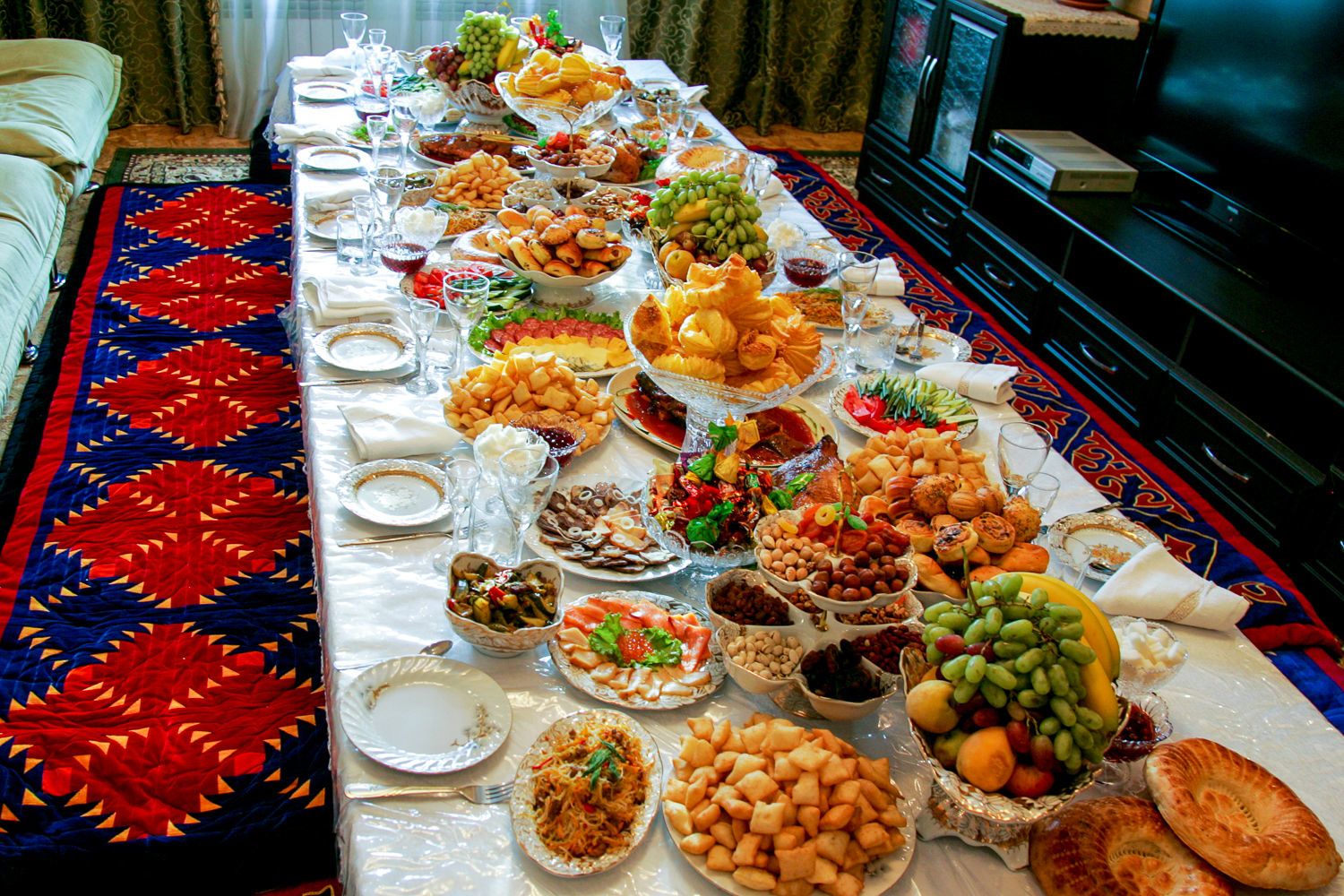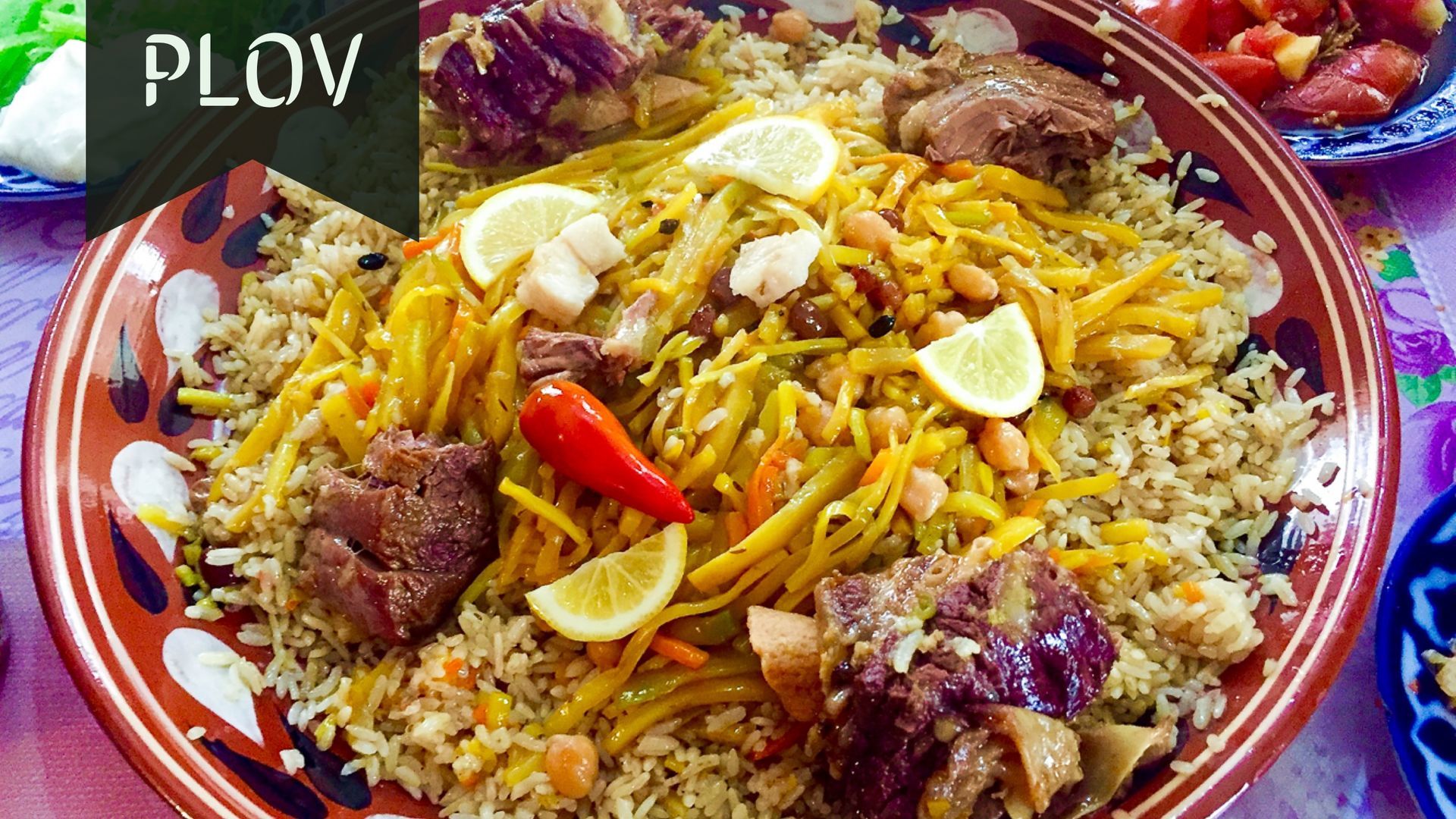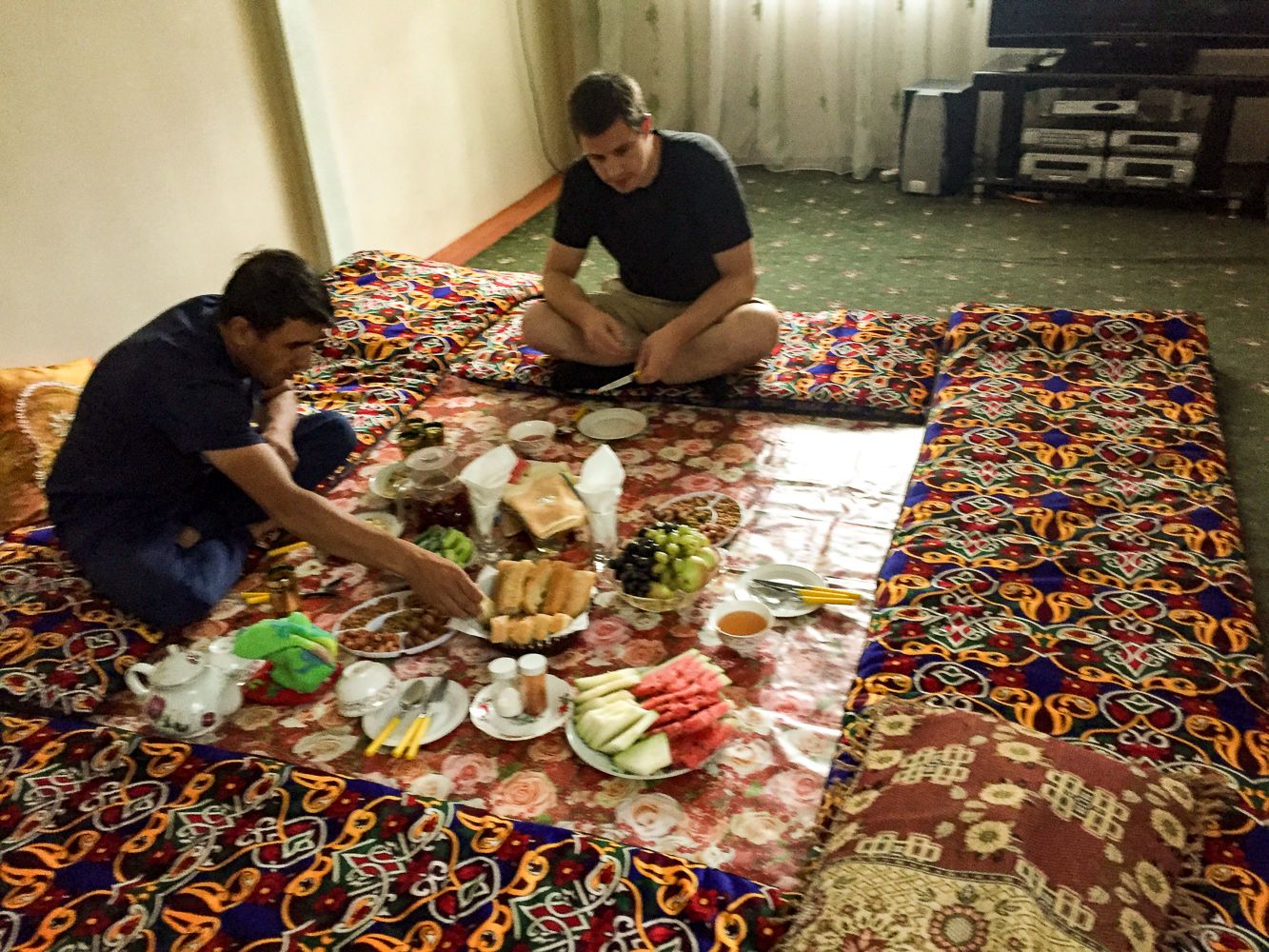Introduction to Central Asian Cuisine
Food plays a pivotal role in any travel experience, prompting a mix of excitement and curiosity about the diverse flavors one might encounter. As you gear up for a journey through Central Asia, our compiled food guide aims to provide a clear picture of what awaits you. Delving into Central Asian Cuisine, we’ll demystify dishes like lagman, plov, manty, and beshbarmak, commonly found on the menus of local restaurants and cafes.
In addition to highlighting the region’s food habits, our guide delves into the cultural and historical peculiarities that have contributed to the unique flavors of Central Asia. It sheds light on the fundamental aspects of a Central Asian nomad’s diet, marked by a reliance on meat and dairy. Contrasting this, you will gain insights into the dietary preferences of settled communities, known for their affinity towards vegetables, rice, and noodles. Moreover, our exploration extends to the imprint of Russian culinary traditions, evident in the region’s gastronomy owing to its historical connection to the Soviet Union.
Spices
Although Central Asia has a variety of spices, its food and cuisine is not too spicy. It is usually mild and uses fresh produce from the nearby region.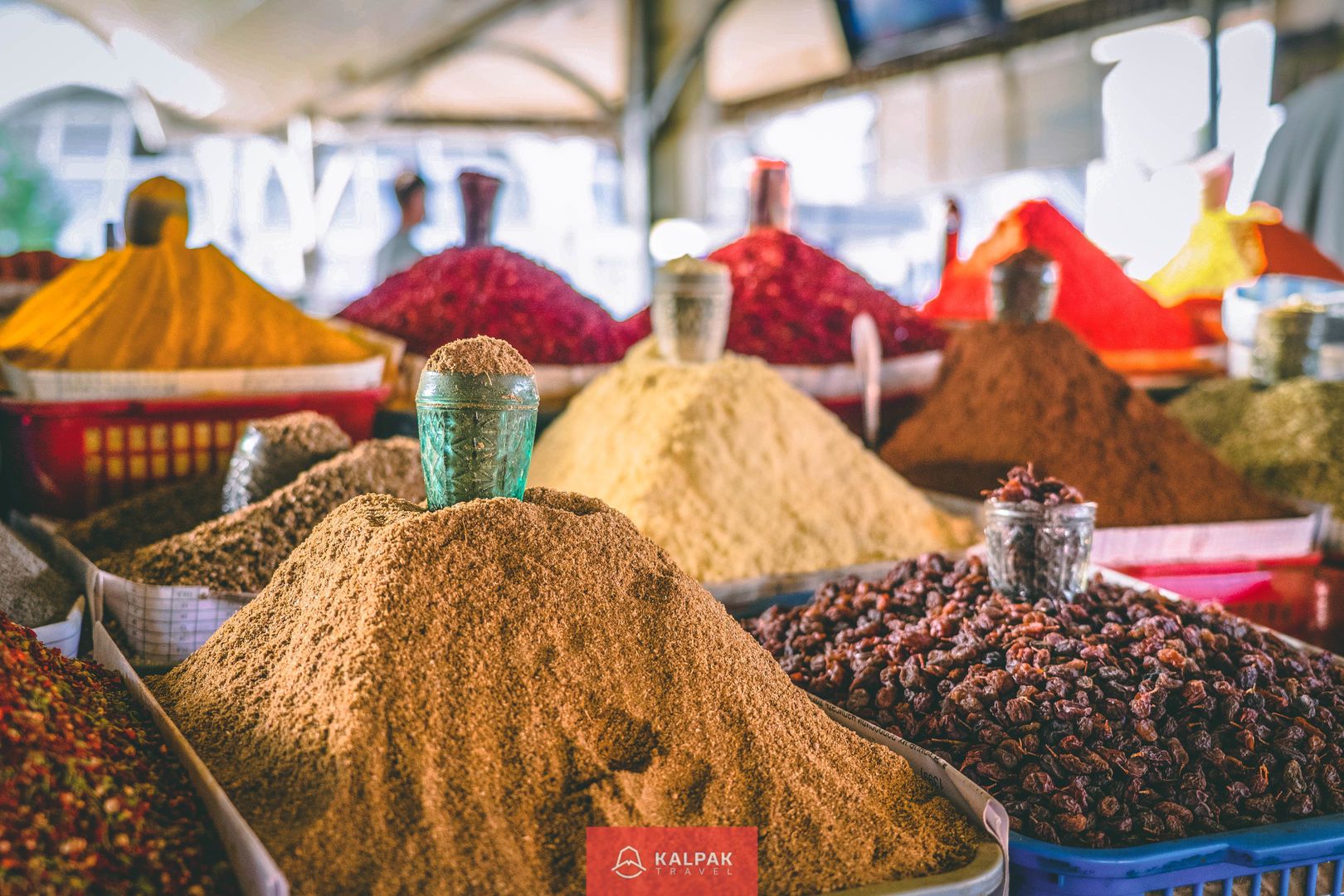
Bread – Lepyoshka, Tandyr Nan, Patyr Nan – Лепешка /Нан
In Central Asia, a meal without bread is considered incomplete. It’s almost sacred here! You’ll find a variety of bread in stores and cafes, but the most common and popular one is a round shaped flat white bread. Typically, it’s baked in a fire oven known as a tandyr (tandoori). As you travel, you will discover that the taste and shape of this bread will vary slightly from place to place.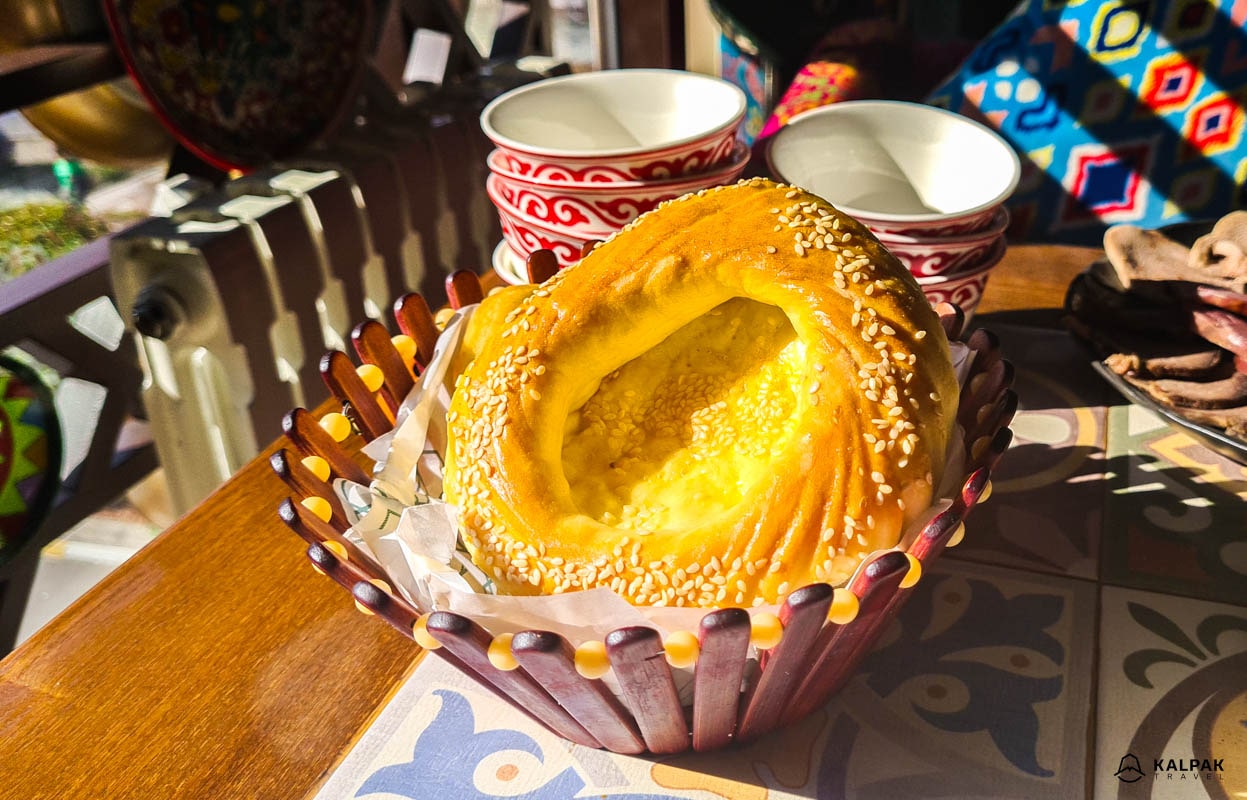
In Central Asia, when people go to a cafe or invite guests they set the table with different appetizers, various salads, fruits, vegetables, jams, honey, and sweets. The bread is typically served by default most of the time, as Central Asia loves to eat bread with every meal. The goal is to have a table full of delicious things with plenty of choice. If you order a salad, soup, main course and dessert, it might all come at once. You are not expected to finish all the food on the table. 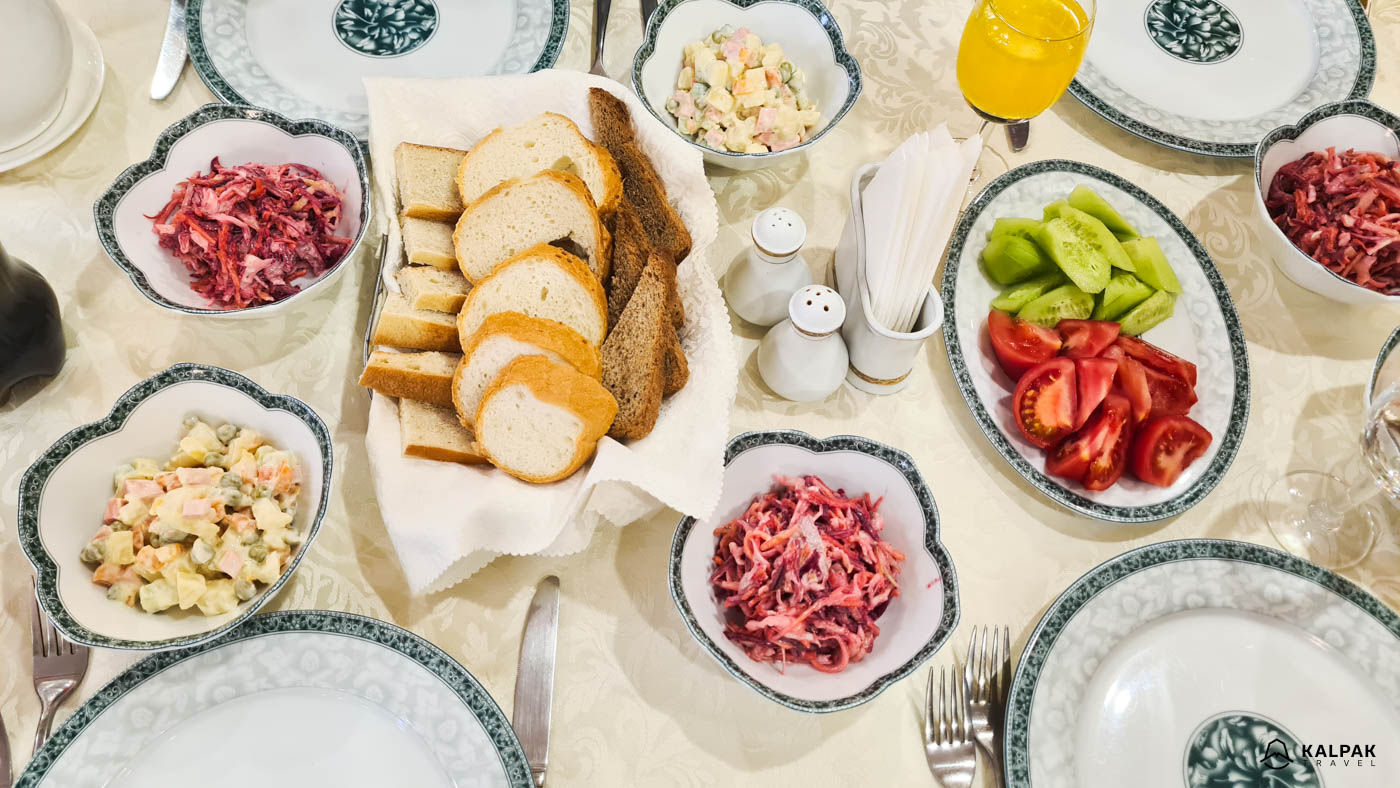
Boorsok / Baursak / – Боорсок/Баурсак
In Central Asia, little fried pieces of dough are made for special events or respected guests. They’re also served as appetizers in restaurants. They are a bit like doughnuts, but not sweet. In restaurants, it is often served with a double cream dip.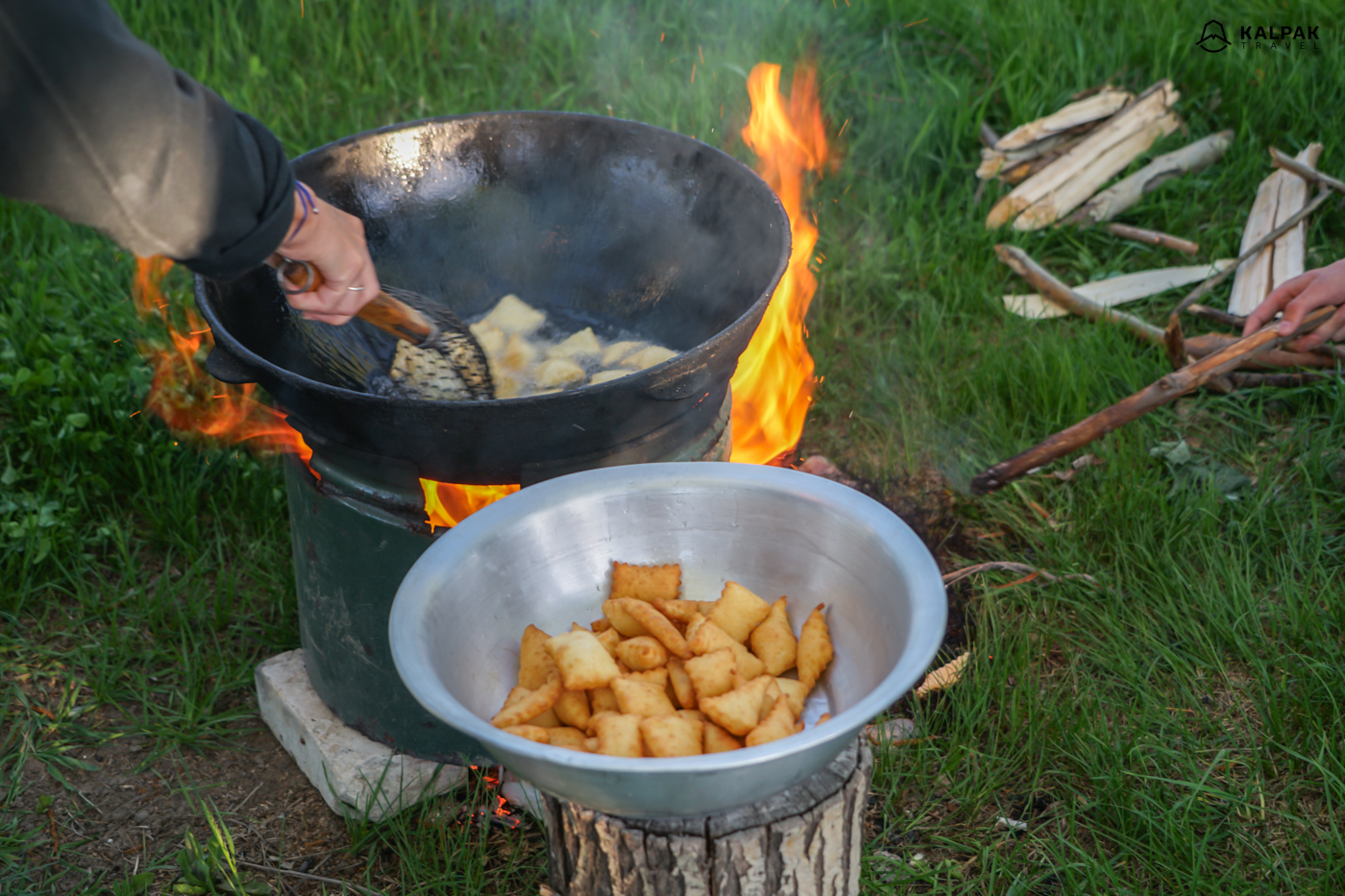
Fresh Salads – Свежий салат [SVEZHIY SALAT]
The salad that’s most typical in Central Asia is a tomato, cucumber and onion salad. The dressing can be mayonnaise or oil, but most often it’s just sprinkled with salt, pepper, and fresh herbs. Most of the salads are made with produce that’s grown locally. You can also get aubergine, carrot, beet or cabbage salad. However, if you travel in summer, your seasonal salad will be tomato and cucumber.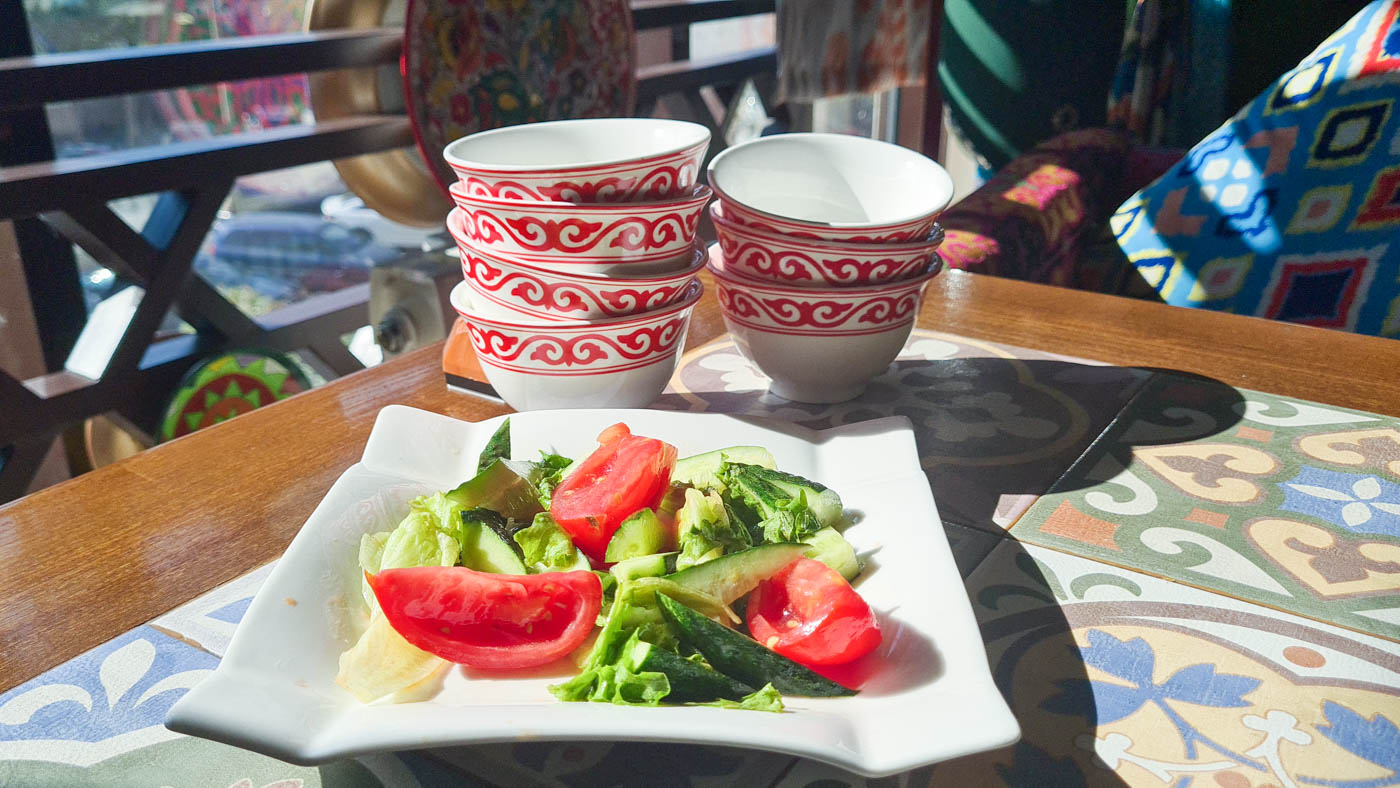
However, if you’re in a larger city, or a restaurant with a more extensive menu, you’ll find a much wider variety of salads from which to choose. You’ll find everything from Caesar to Greek. Many local salads, soups, and meals include a generous portion of additional herbs like dill, parsley, chives or cilantro. Other herbs like basil, oregano, and rosemary are used less often in Central Asia. It’s best to try out the salad with herbs first, but remember if that makes the flavor too strong, you can always ask the chef to prepare a salad for you without them. 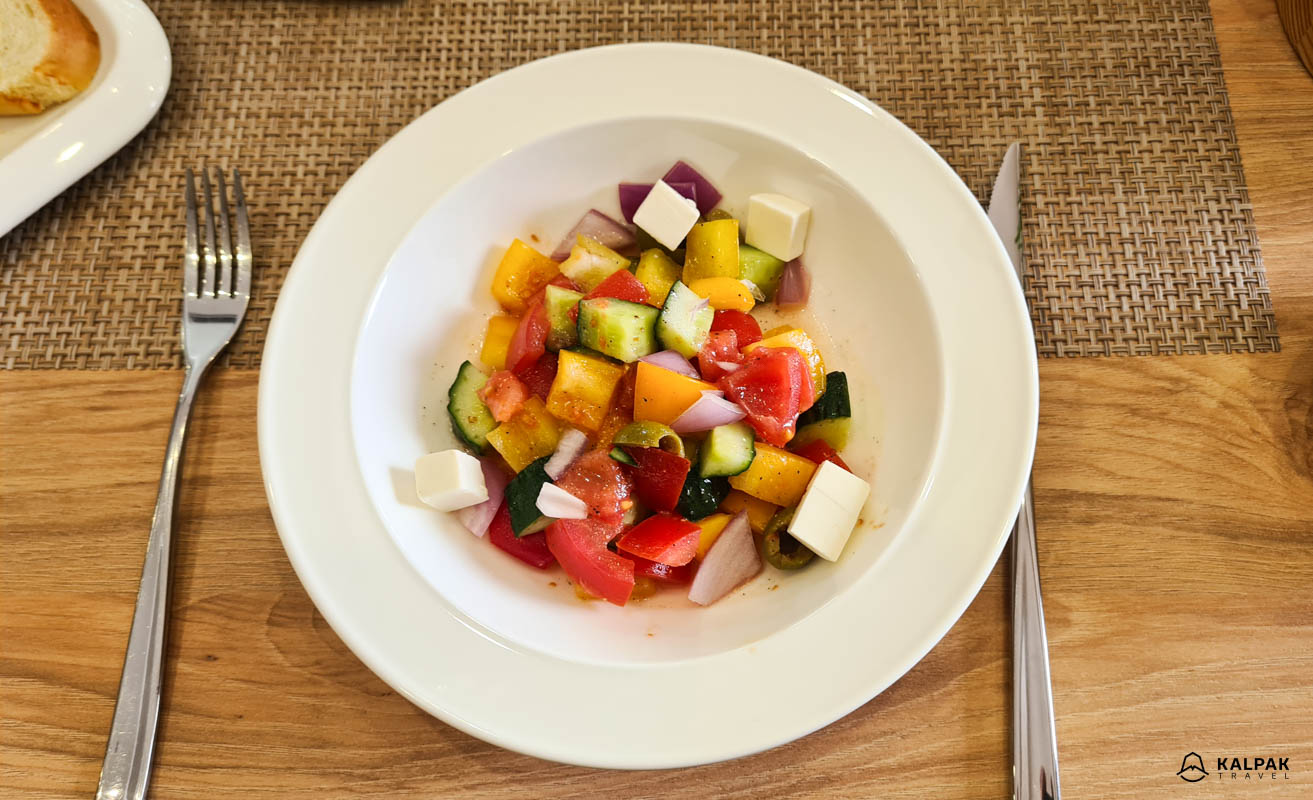
Soup – Суп
Soups are very popular in Central Asia, even on the hottest of summer days. Shorpo or Shurpa is a meat broth soup with big pieces of meat, very often fatty mutton. Its other ingredients comprise pieces of carrot and potato and of course a sprinkling of fresh herbs. Variations of this soup also include noodles or beans cooked in the meat broth. They are very popular in mountainous regions of Tajikistan and Kyrgyzstan.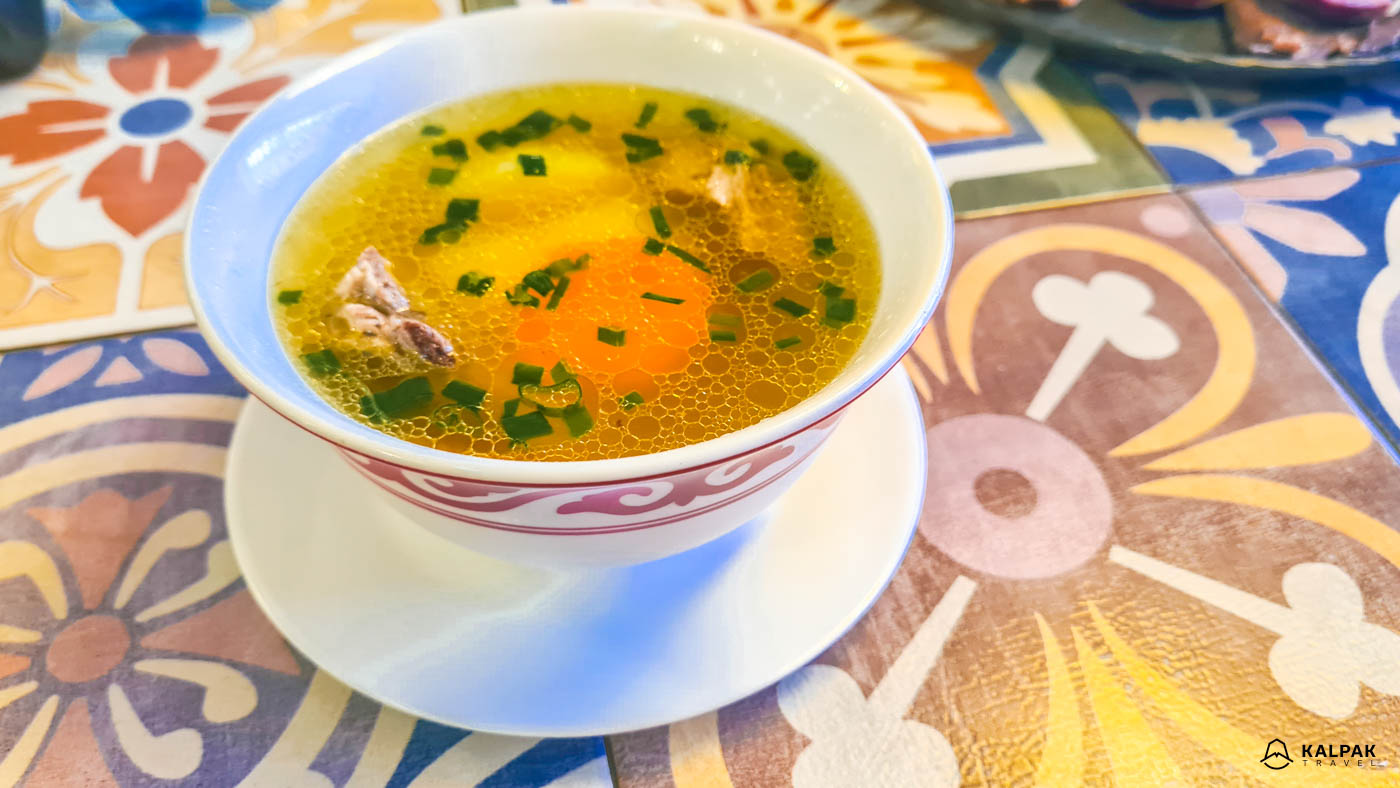
Borsch – Борщ
As you might expect from the influence of Soviet times, borsch is also popular. This red beet soup originates from Eastern Europe and Russia and is now widely found in Central Asia too. It contains meat, usually beef, as well as potatoes, cabbage, red beets and a bit of carrot and onion to round out the flavor. It’ll be served with a swirl of sour cream and a sprinkling of dill, but you can ask for it to be brought to the table without this garnish. 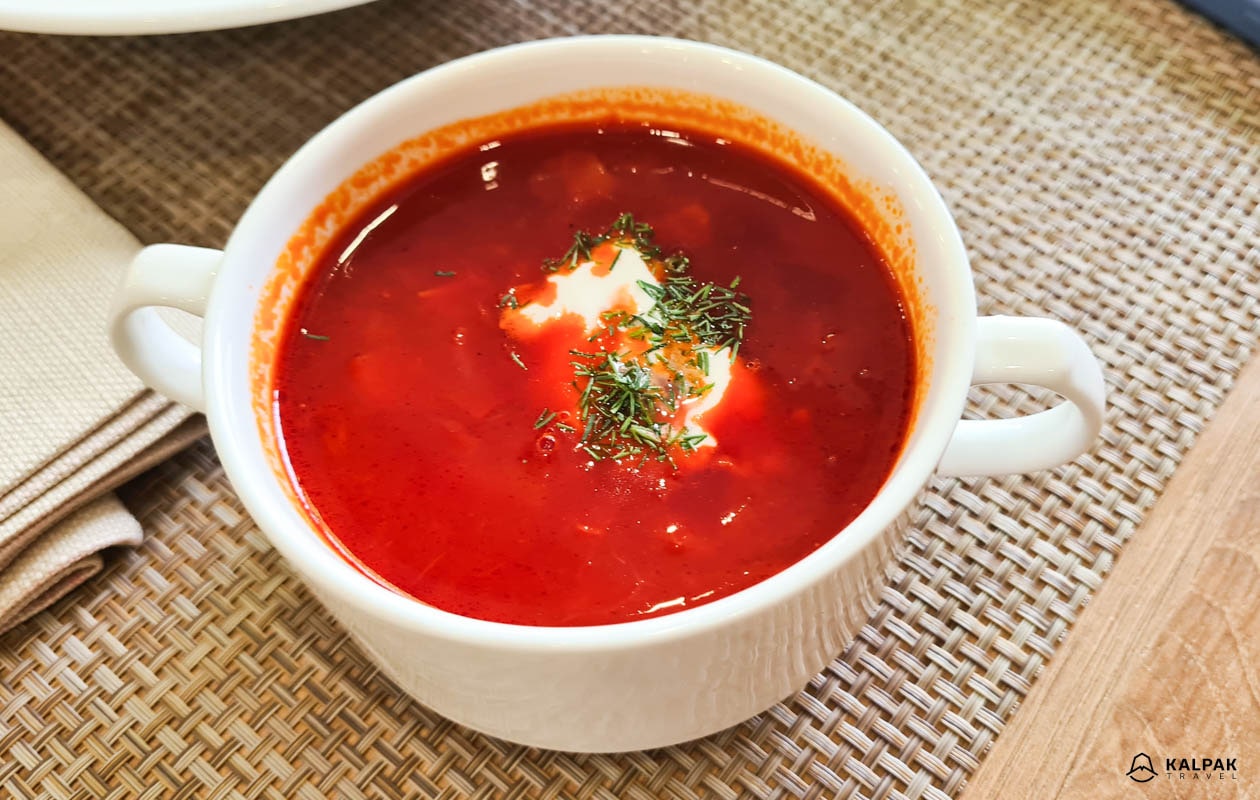
Lentil soup – Чечевичный суп [Chechevichniy Sup]
You’ll find lentil soup on offer in many restaurants, especially in large cities. Lentil soup is also often served with a spoonful of sour cream – remember you can opt out of this if you wish – and a slice of lemon. The lemon can be squeezed into the soup to taste.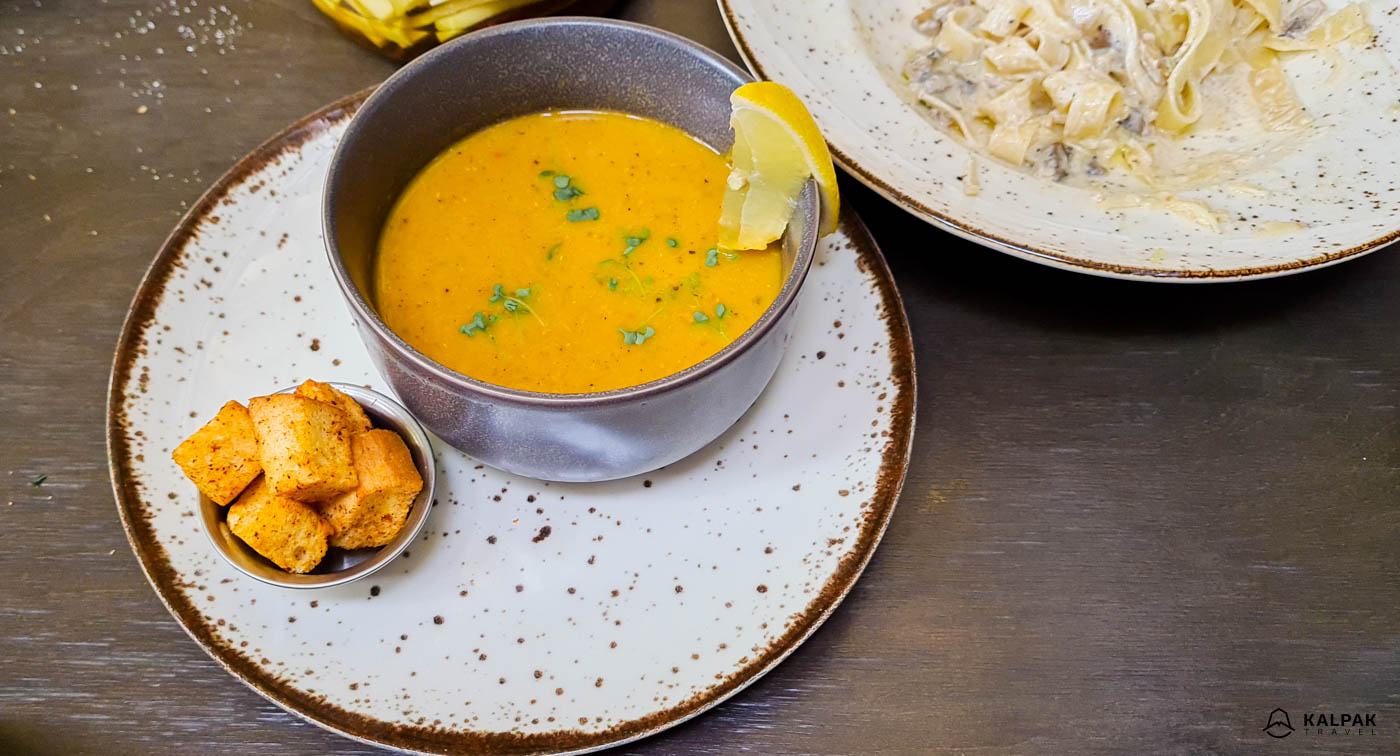
Plov |Pilaf |Paloo |Osh |Ash – Плов | Пилав | Палоо | Ош| Аш
There are around 200 varieties of plov. It’s so important that it is featured on Tajikistan and Uzbekistan’s Representative List of Intangible Cultural Heritage of Humanity as listed by UNESCO. Nationwide competitions are held to see who can make the best plov. It is of great social and cultural significance to the local population and as a consequence, served at all big events and ceremonies.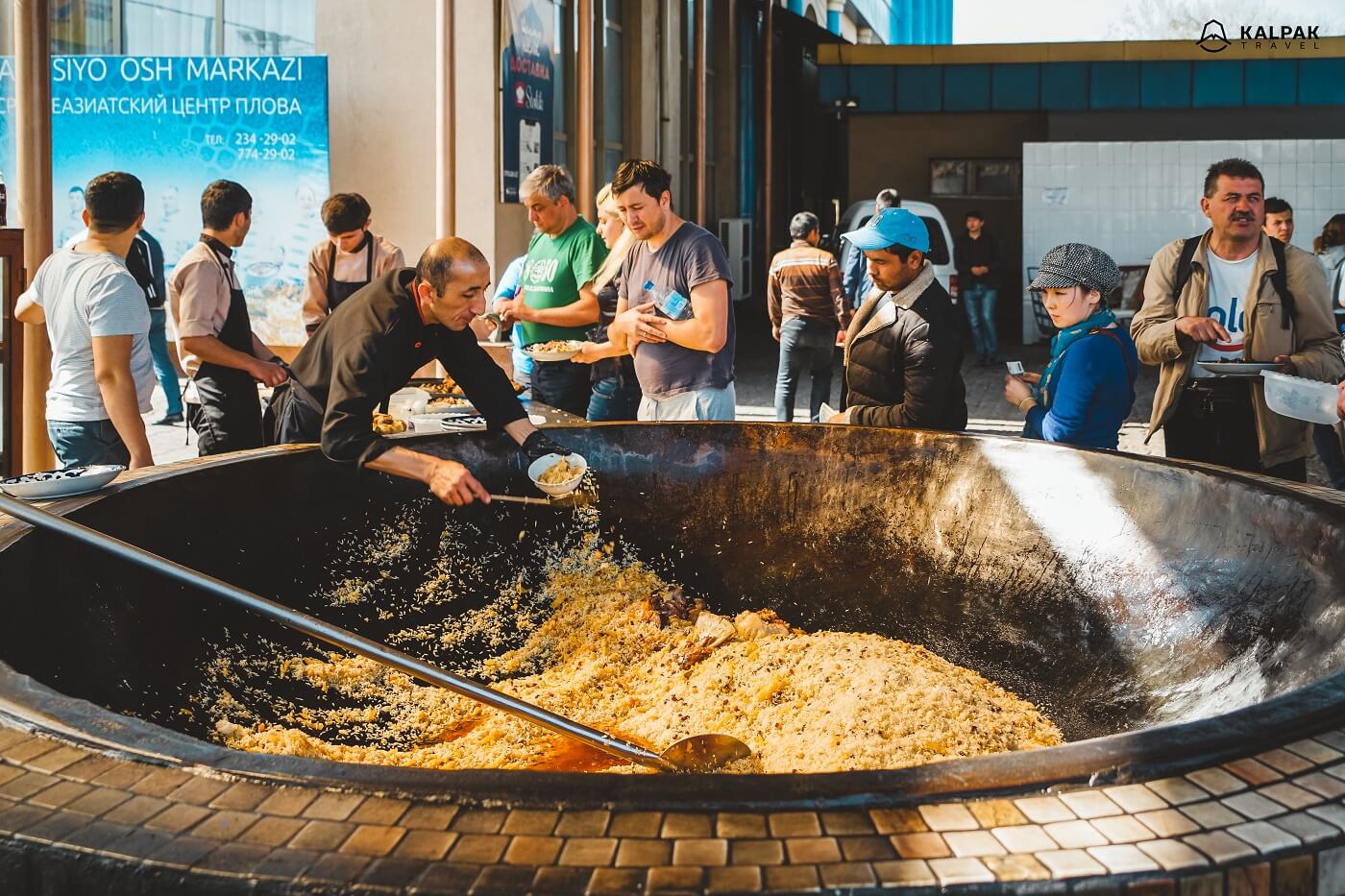
Its main ingredients are lamb or beef fried in a large kazan (cauldron) with onions and yellow or orange carrots. It’s cooked for around an hour. It can be served additionally with kazy (local sausage), eggs and, occasionally, with lemons. The best places to try plov in Central Asia are Samarkand, Penjikent, Shymkent and Osh, although every city and even family has its own special plov recipe.
Besh Barmak (KG) | Naryn (UZ) |- Беш Бармак
Besh Barmak literally means five fingers, as people used to eat it with their fingers in earlier times. It is the national dish of Kyrgyzstan and Kazakhstan. The core ingredients of Besh Barmak include boiled meat, traditionally lamb or beef, which is then finely chopped and served on a bed of thin pasta sheets. The dish is often accompanied by onions and in Kazakhstan with potatoes and large pieces of meat. Besh Barmak has historical roots in the nomadic lifestyle, where communities would come together to celebrate special occasions, festivals, and communal gatherings. Besh Barmak held special significance for nomads, as their diet primarily consisted of meat. The addition of noodles, obtained through trade with settled communities, brought a touch of luxury and specialty to this traditional dish.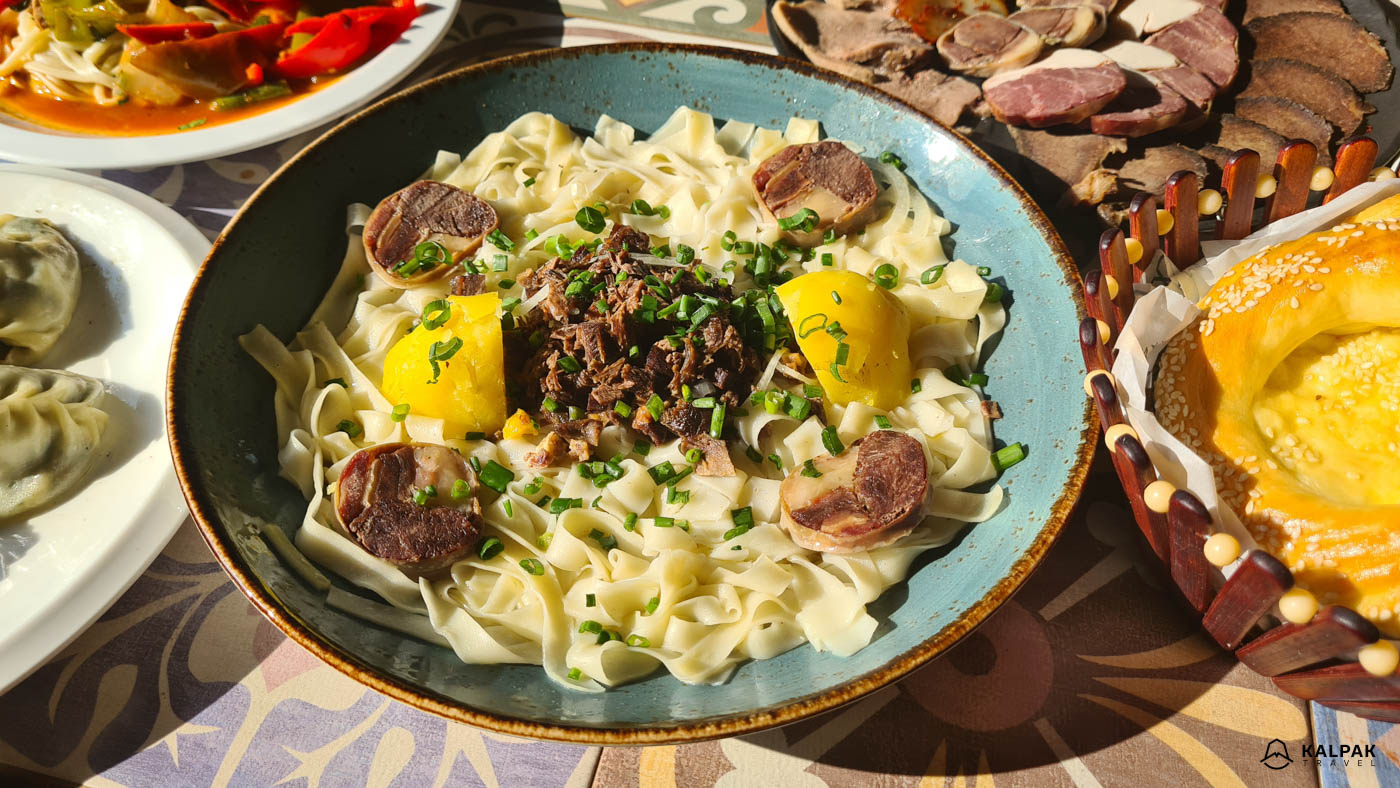
Kuurdak – куурдак, куырдак, говурдак
Kuurdak is a one-pot meal consisting of fried meat, potatoes and onions. Traditionally it is made from mutton or beef with a generous portion of fat. First, the meat is fried with onions and then stewed. When a sheep is freshly slaughtered, the liver, kidney and heart would be used in this dish. This is more common in homestays or guesthouses. In cafes, it is usually served just with meat and without such internal organs.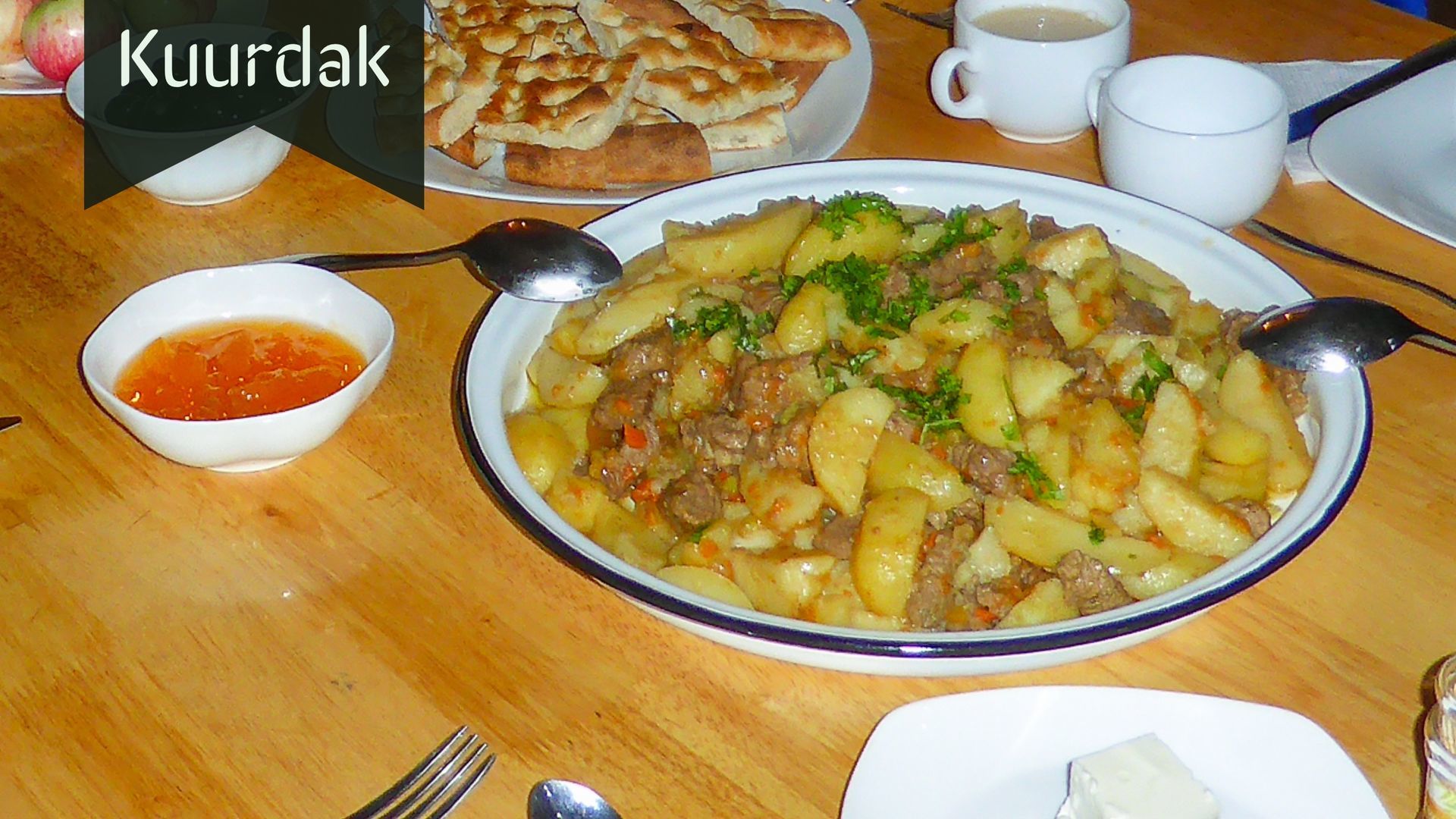
Chuchuk (Kyrgyzstan) | Sujuk/ Kazy (Kazakhstan, Uzbekistan) – Казы
This traditional delicacy is served as an appetizer or together with national dishes such as plov and beshbarmak. It is a type of meat sausage, generously spiced with black pepper. It is basically horse meat with fat stuffed into thoroughly washed and salted intestines. There is also a smoked variety as well as the more commonly served fresh one; both are usually served cold.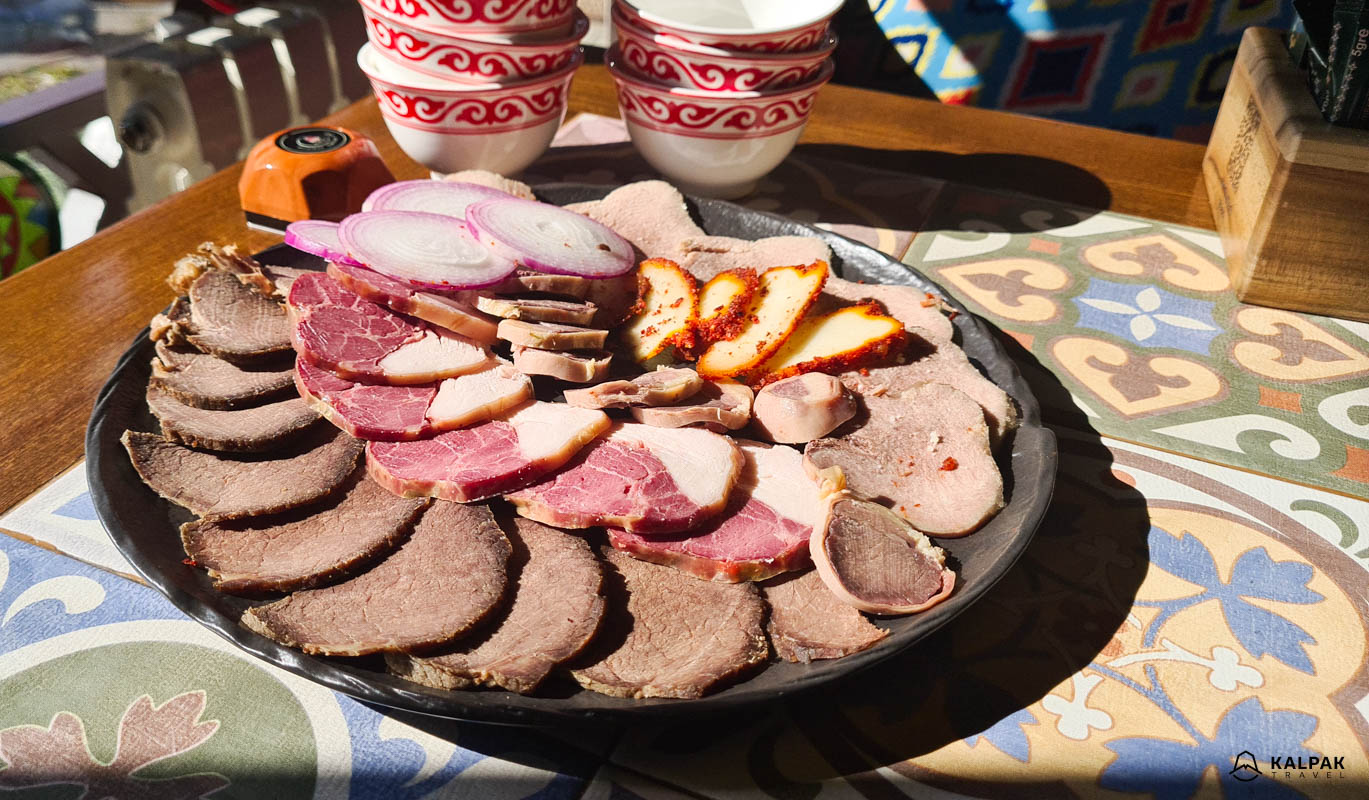
Meat Skewer – Shashlyk – Шашлык
Shashlyk is a very popular meal in a region stretching from Central Asia to Eastern Europe and the Mediterranean. It is usually made from mutton or beef; alternating pieces of meat and fat are well spiced and marinated. It is served with pickled onions. It can be ordered as an add on to the main national dishes or separately as a side dish. In many cafes you can also get chicken, chicken wings or assorted shashlyks, prepared just like at barbecues over hot coals.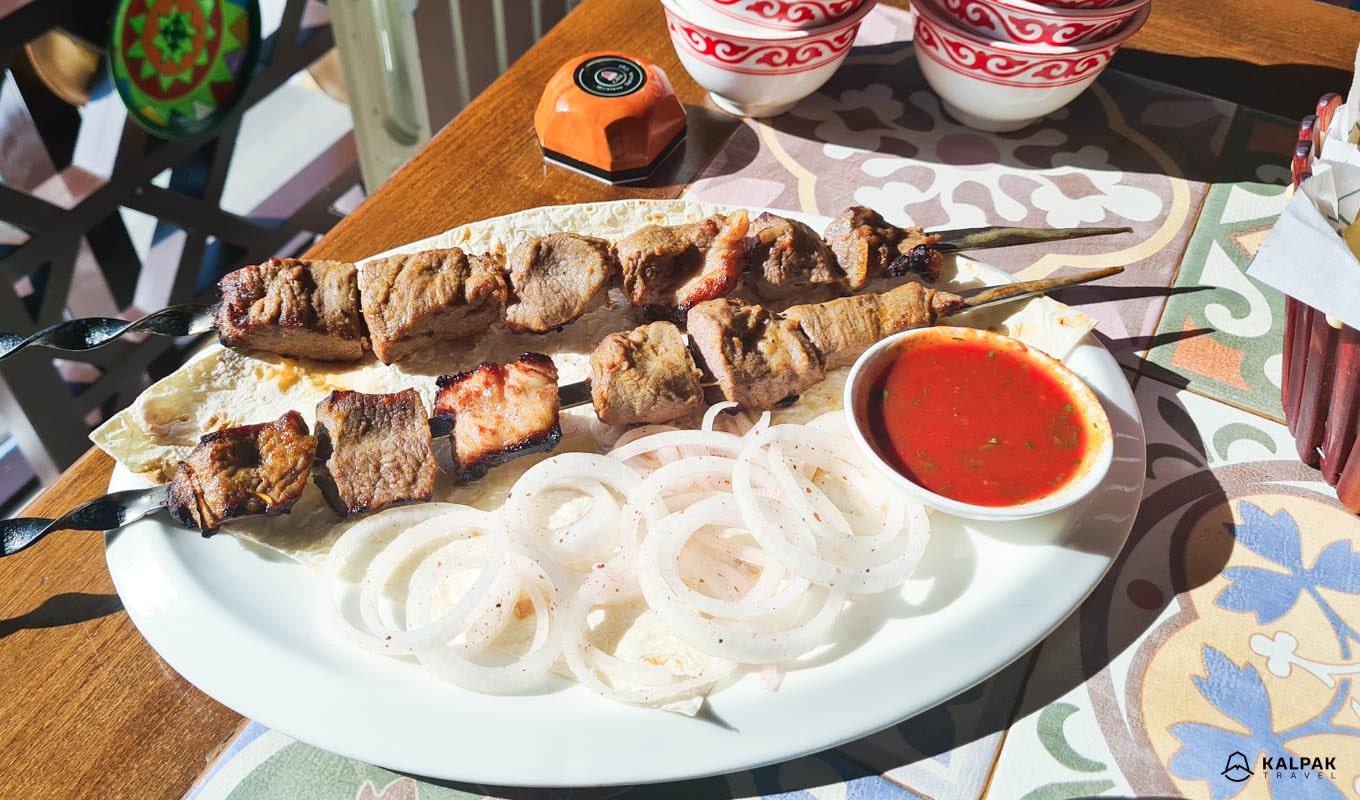
Laghman – Лагман
Lagman is basically handmade pulled noodles in a meat or vegetable sauce. The meat is usually beef, while the vegetables include bell peppers, garlic, onion and fresh herbs. Depending on the location, additional vegetables are added. It has numerous variations from soups to main course dishes. Plain Lagman is a soup, Gyuro Lagman is the one on the photo. Boso Lagman has fried short noodles. If you find the same sauce served with white rice the dish will be called Gan Fan. Its origins can be traced back to China, specifically to the Uighur and Dungan minorities of Western China, who migrated to Kyrgyzstan in the 19th century. This culinary connection probably also reflects the historical Silk Road interactions, highlighting the cultural exchanges and influences along this ancient trade route.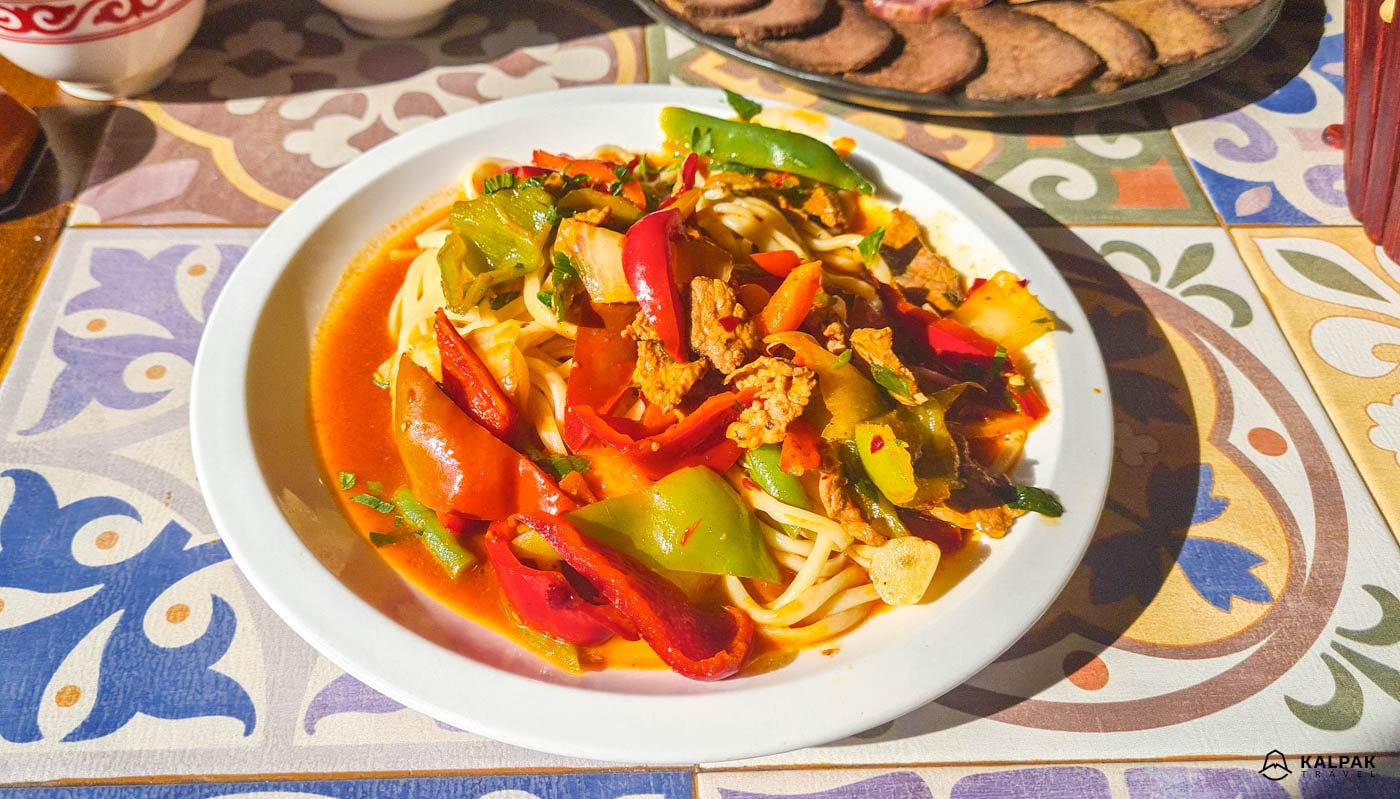
Manty – Манты
Manty is a dumpling stuffed with minced meat, fat and onions. It is cooked over steam and served with ketchup, vinegar or sour cream. There are also variations with pumpkin or potatoes without meat, though you won’t find these variations in every restaurant. One portion usually comprises five dumplings. Small pieces of dough with a meat filling looking like ravioli are called Pelmeni, pieces filled with mashed potatoes are called vareniki.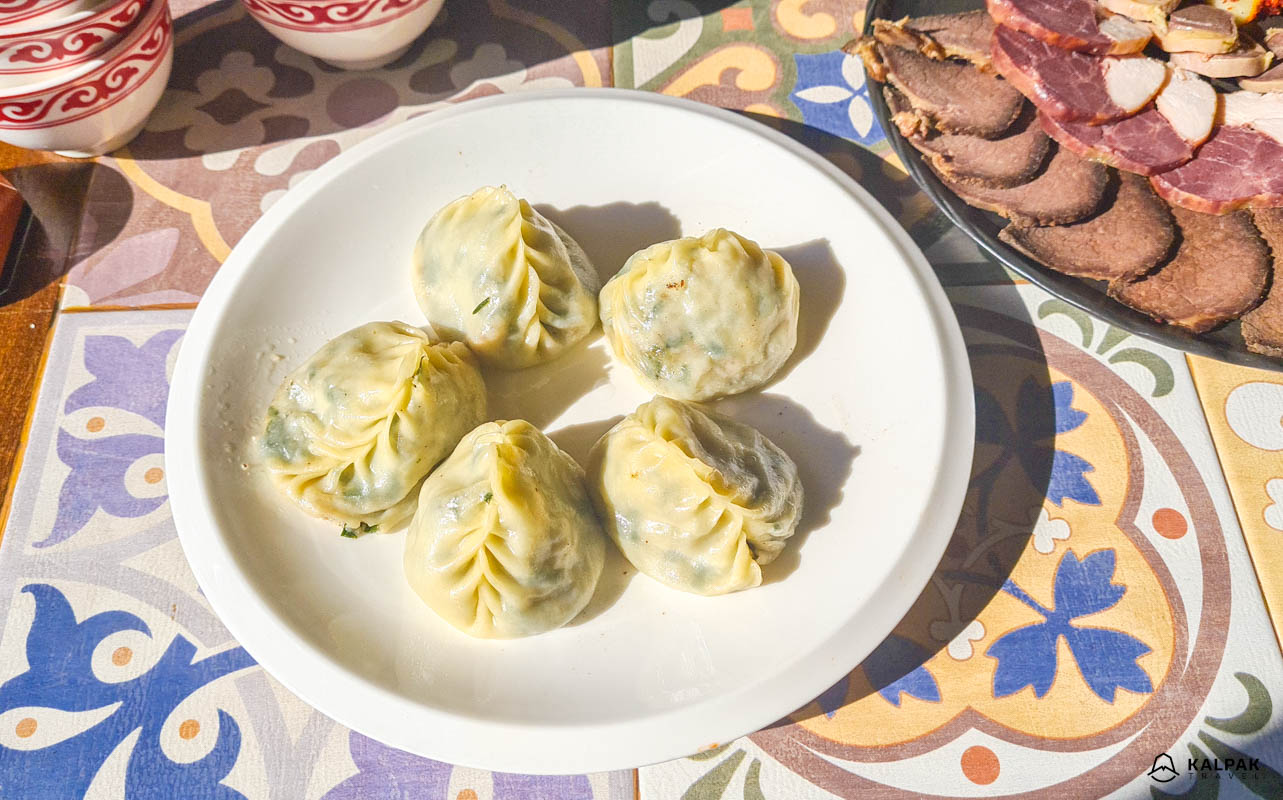
Meat dishes – мясные блюда [Myasnye Blyuda]
Meat dishes are very popular in Central Asia. Meat is usually cooked right through, though a handful of places in the big cities will accommodate a taste for rare or medium steak, usually in international restaurants. Everywhere else, you will be served your meat well done. You can also take a look at a local menu in one of the renown restaurants of Bishkek – Supara with a variety of national and international dishes. 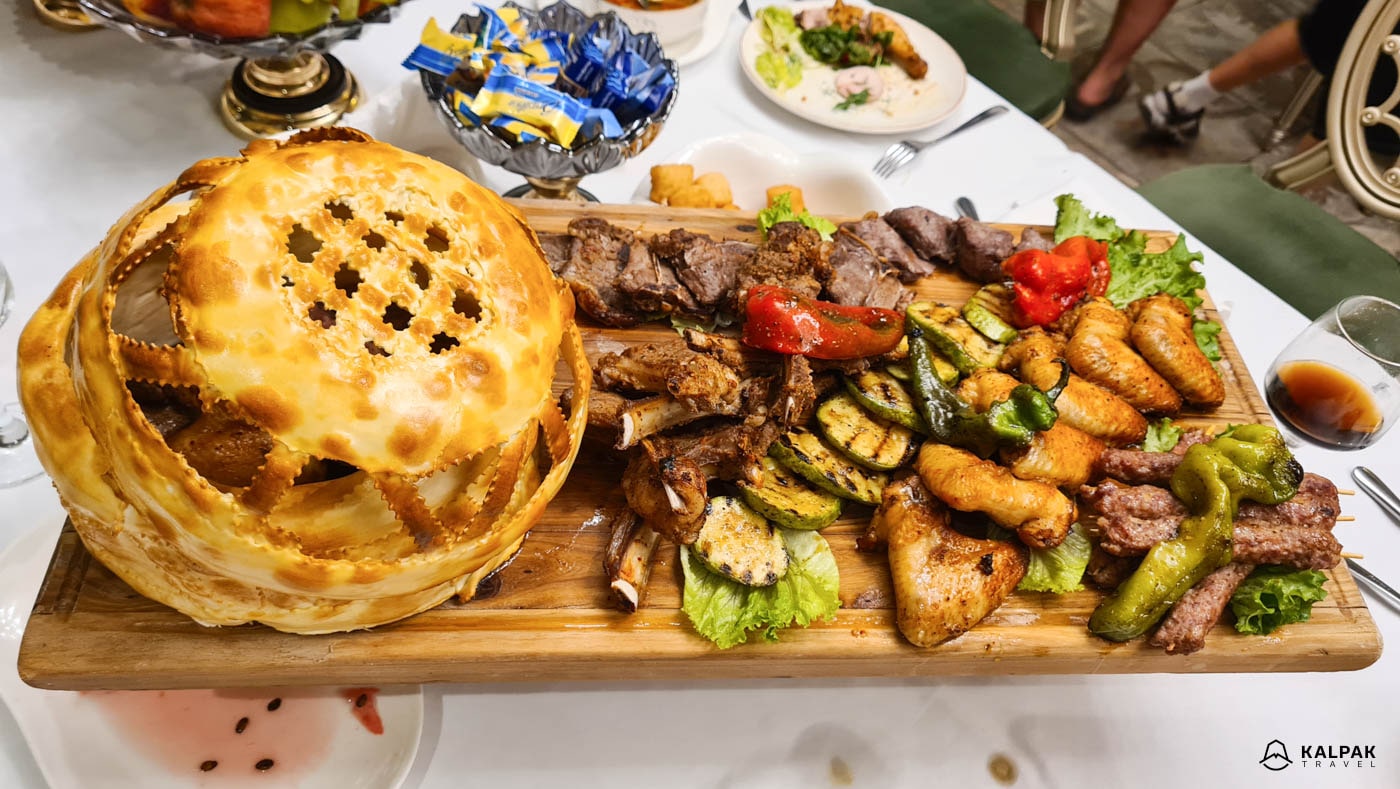
Kotlety – котлеты
Kotlety, also known as meat patties, were introduced to Central Asia through Russian influence. Though they may sound similar to cutlets, they’re more than just meat – they’re made from minced meat mixed with onions and bread. Typically served with mashed potatoes and a savory meat sauce, variations of this dish include adding fried meat mixed with vegetables, and it can be served with mashed potatoes, rice, or noodles. It’s a hearty and comforting meal enjoyed across Central Asia, blending Russian and local culinary traditions.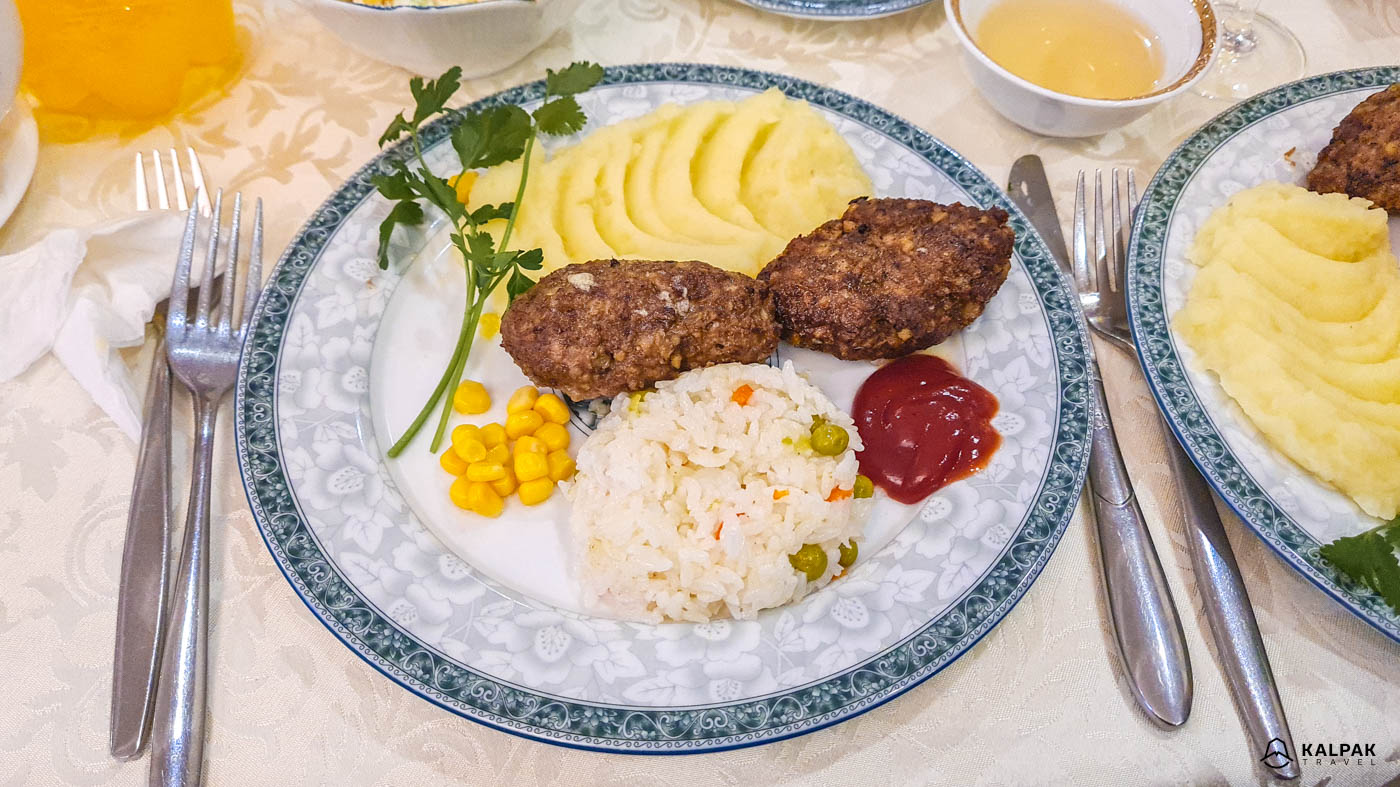
Pelmeni – Пельмени
Pelmeni, a cherished dish in Central Asian cuisine are akin to ravioli. These small dumplings consist of thin unleavened dough filled with a savory mixture of minced meat, typically beef mixed with onions and spices. Pelmeni are traditionally hand-shaped into small pockets and then boiled until they float to the surface, indicating they are cooked. Once prepared, they are often served hot with a dollop of sour cream or a splash of vinegar, adding tanginess to the rich flavors. Pelmeni can be served with or without soup to it.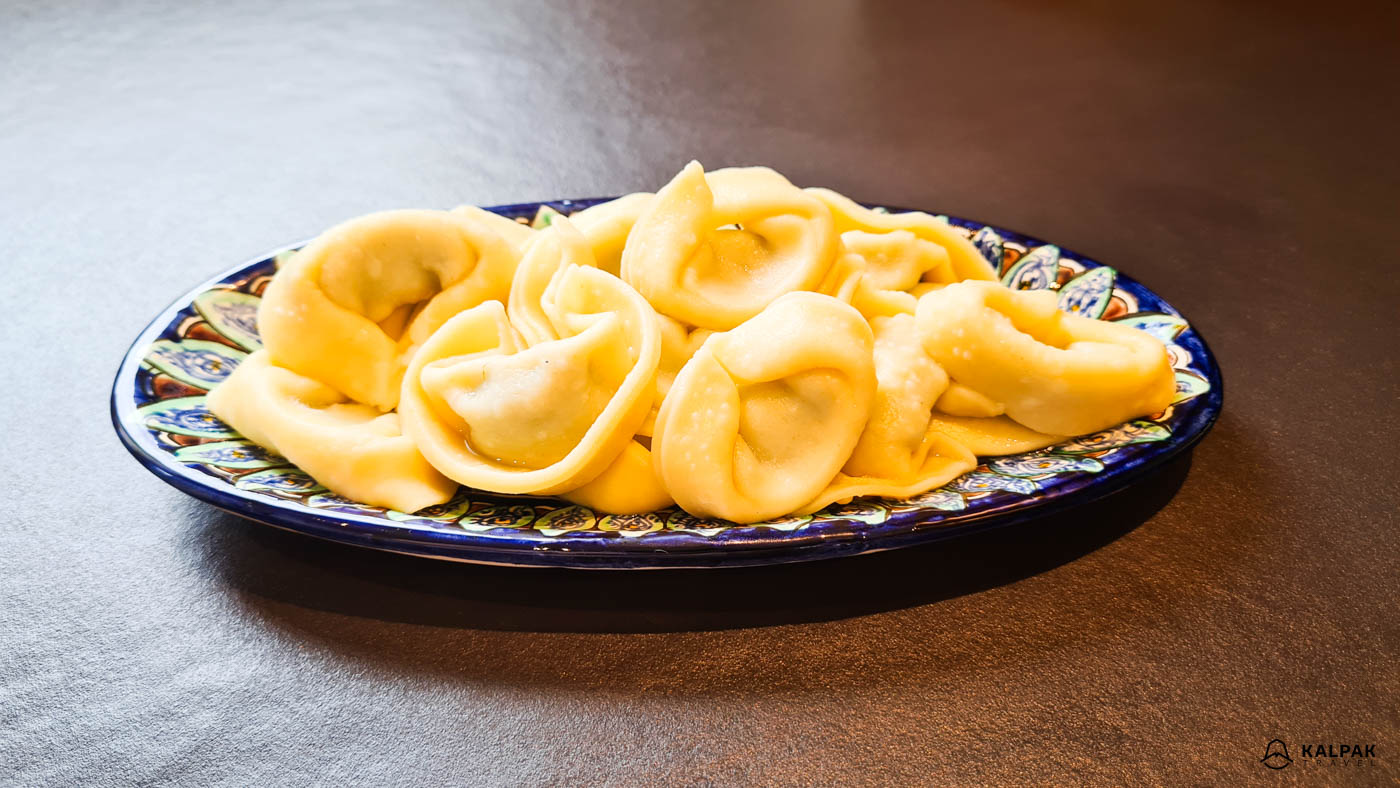
Samsy – Самсы
Samsy is another type of local fast food, sold almost everywhere in cafes in fast food chains or made at home.Indian samosas, triangle-shaped dough stuffed with meat or vegetables, were introduced to India by Central Asian traders in the 13th and 14th centuries. In Central Asia, they are always stuffed with meat and onions, and unlike samosas, baked in the oven and never fried. Occasionally, you’ll find samsy with a cheese or potato filling.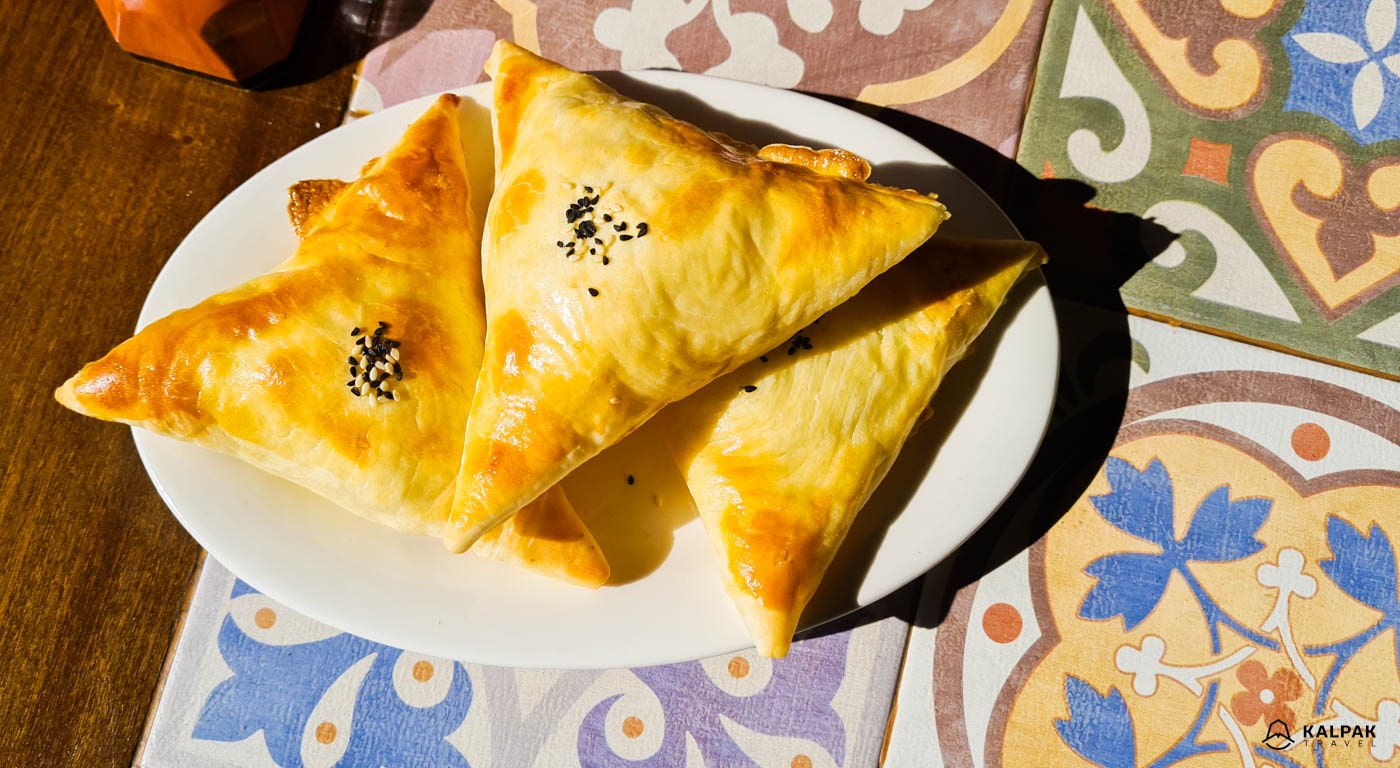
Tandyr Samsy – Тандыр самсы
Tandyr samsy is quite different from regular samsy as it is baked in a special tandyr (tandoori). These are fire clay pot ovens. The dough is filled with meat, fat and onion stuffing, however, it has more sauce in it. It is usually served with a pot of tea or even a meat broth. You need to cut the hard bottom side, eat the inside filling with a spoon and then soften the dough in the broth or tea before you eat it.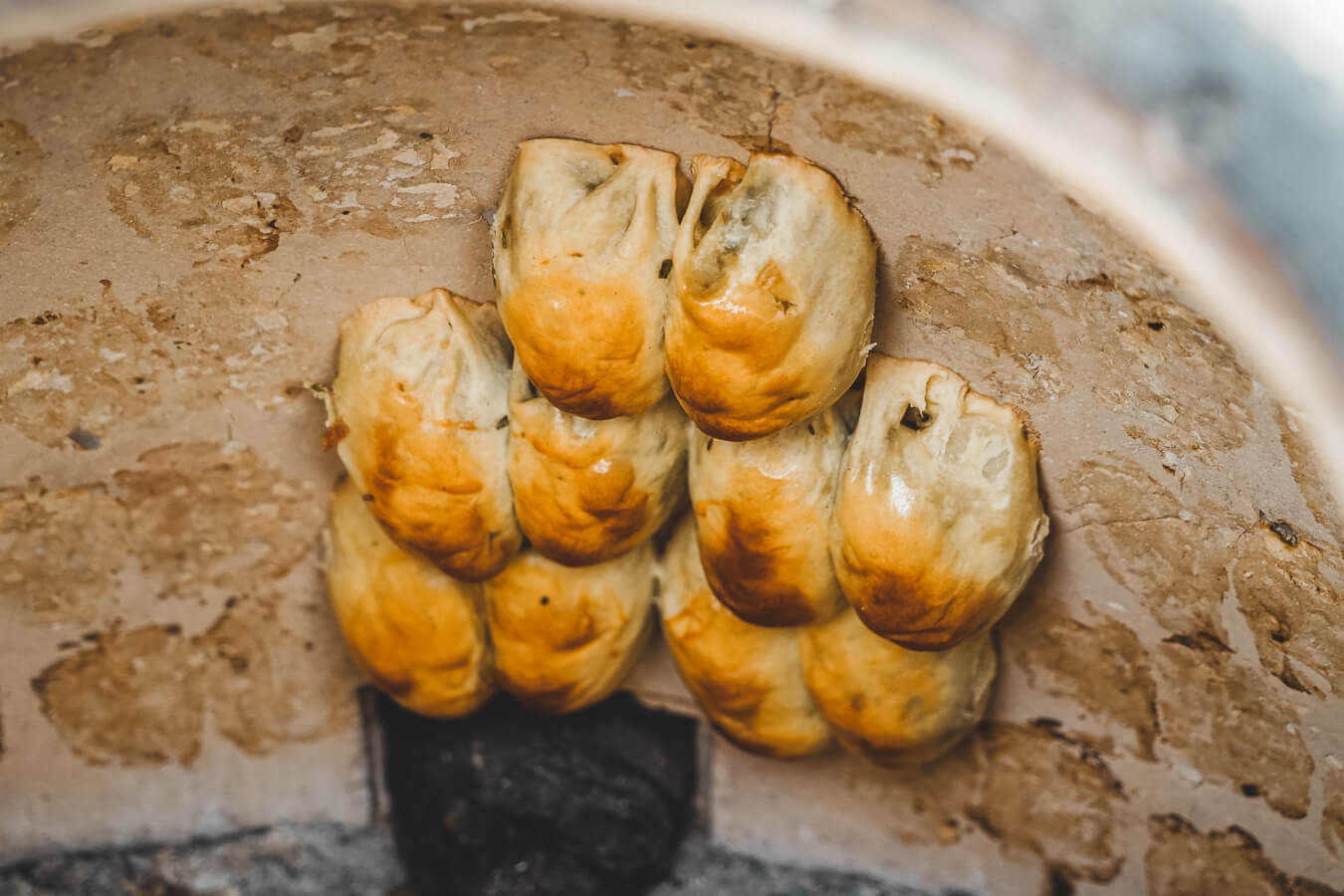
Fast Food: Pizza/ Burgers/ Wraps – Pizza / Gamburger / Shaurma – Фаст Фуд /Пицца/ Бургер/ Шаурма
Fast food is widespread in Central Asia, although it’s only in Kazakhstan that you’ll find international fast food giants like McDonalds or Burger King. In the other Central Asian countries, you’ll have to be content with local variations of burgers and pizza. You can even find pizza with traditional sausage. Outside the cities, there is practically no fast food. In rural areas especially, you’ll be served a diet of local cuisine instead.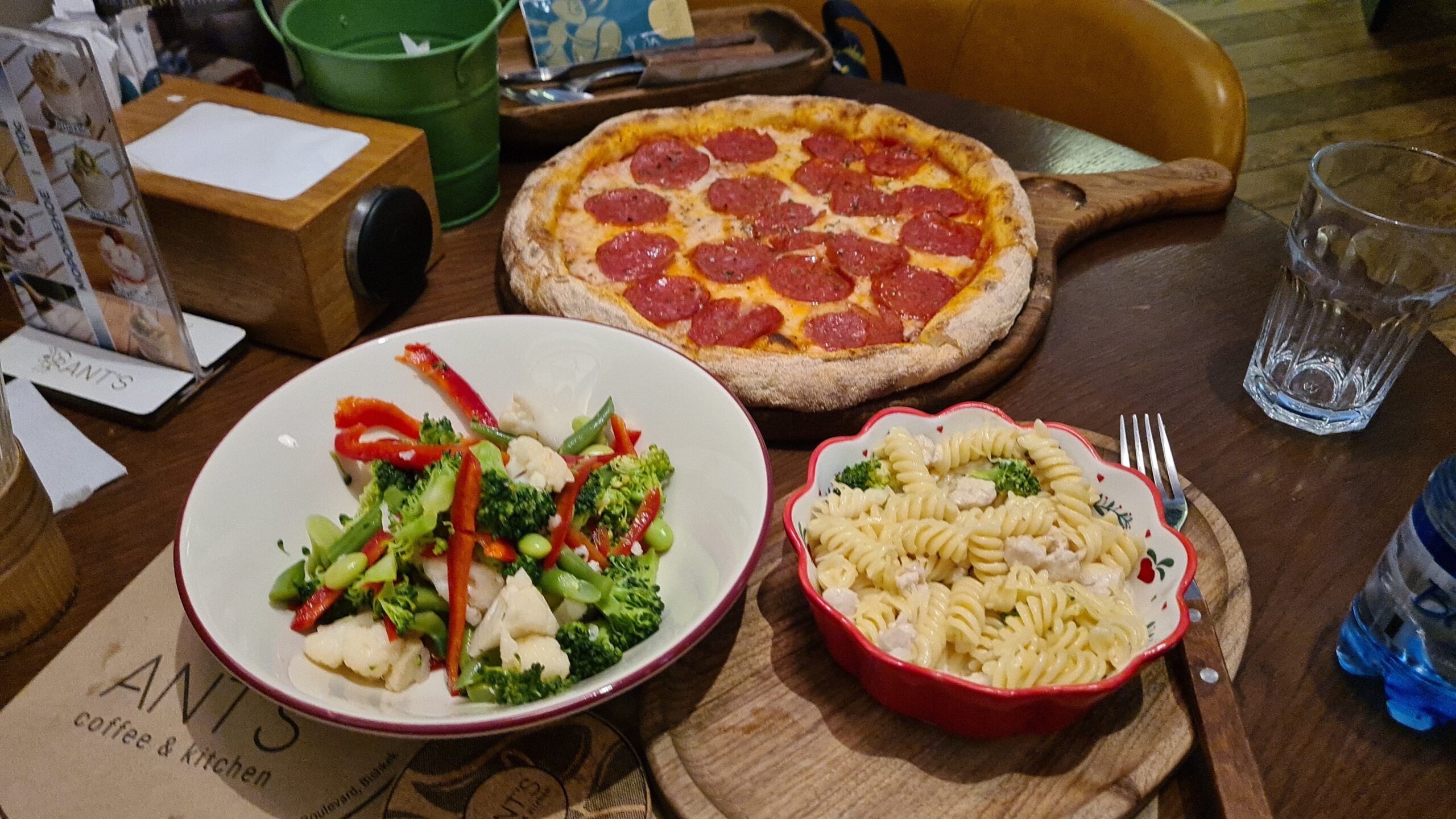
Eating in Cafes & Restaurants of Central Asia
In Central Asia, when people go to a cafe or invite guests they set the table with different appetizers, various salads, fruits, vegetables, jams, honey, and sweets. The goal is to have a table full of delicious things with plenty of choice. If you order a salad, soup, main course and dessert, it might all come at once. You are not expected to finish all the food on the table.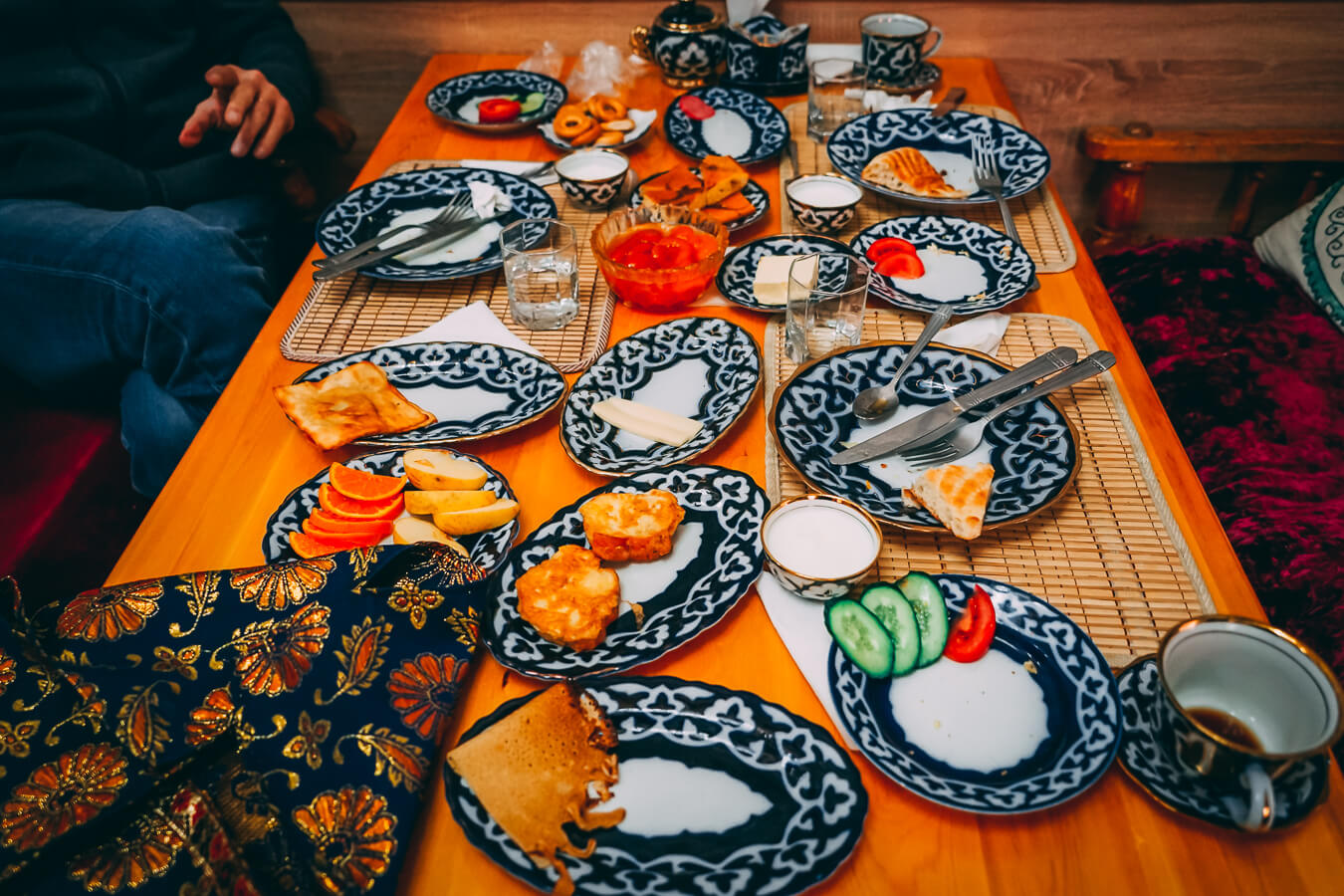
Eating in guesthouses
Many guesthouses and homestays in the countryside serve dinner on the floor. The floor is covered with a tablecloth surrounded by special homemade cushions to sit on. It is often done for guests as an honor in a special dining room. Stepping on the tablecloth or stretching your feet towards the tablecloth is unacceptable – you need to tuck your feet in.
Another variant of sitting on the floor is to eat at a low table with short legs. You still need to sit on the floor, but the meal stays on the table. You might worry about finishing everything that comes to the table, but that’s not expected. It’s polite to leave something, symbolizing you had enough and your hosts provided enough food.
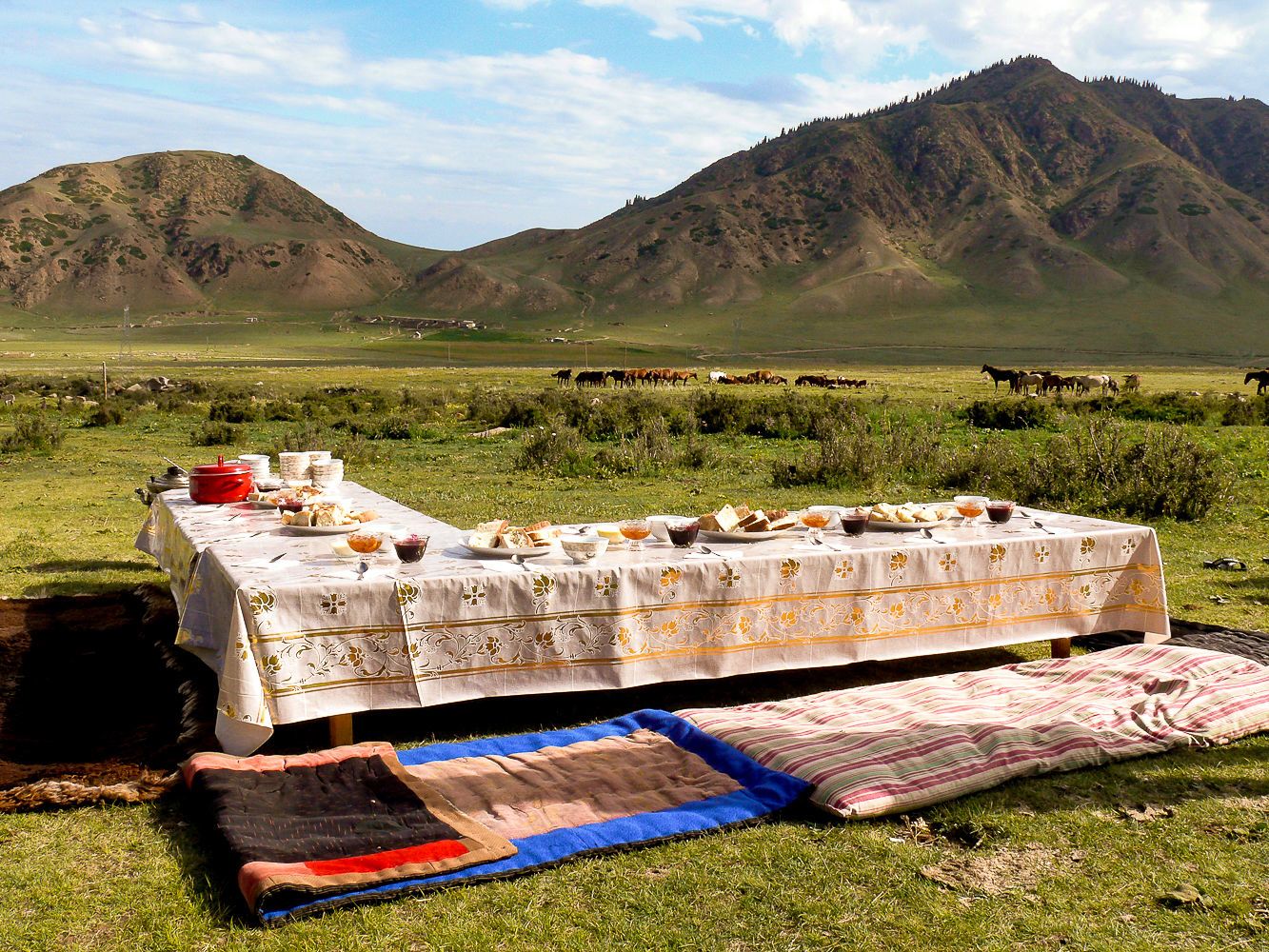
Desert and coffee – Desert i Kofe [Десерт и кофе]
Central Asia is a tea-drinking and meat-eating destination. 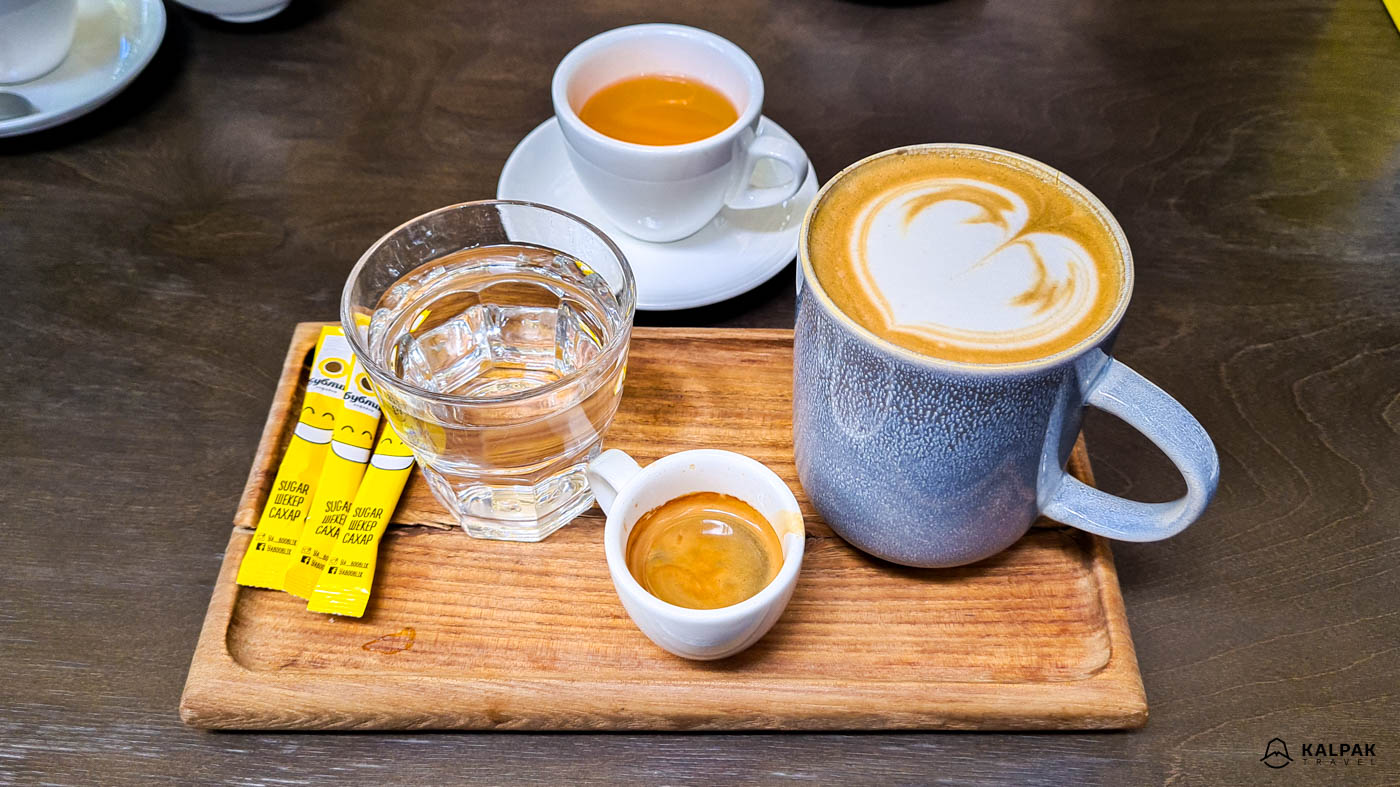 In major urban centers, you’ll encounter familiar Western-style coffee establishments offering a variety of beverages like cappuccino and espresso. However, you’ll find such places aren’t cheap – a cup of coffee can cost almost as much as a meal, expensive by local standards. In rural areas, the coffee landscape shifts, and instant coffee becomes the predominant option.
In major urban centers, you’ll encounter familiar Western-style coffee establishments offering a variety of beverages like cappuccino and espresso. However, you’ll find such places aren’t cheap – a cup of coffee can cost almost as much as a meal, expensive by local standards. In rural areas, the coffee landscape shifts, and instant coffee becomes the predominant option.
Tea – Chai – Чай
Locals drink tea a lot, and even on hot days, hot tea is very popular. In most places, green tea is very common and in cities, you can choose between green and black tea. 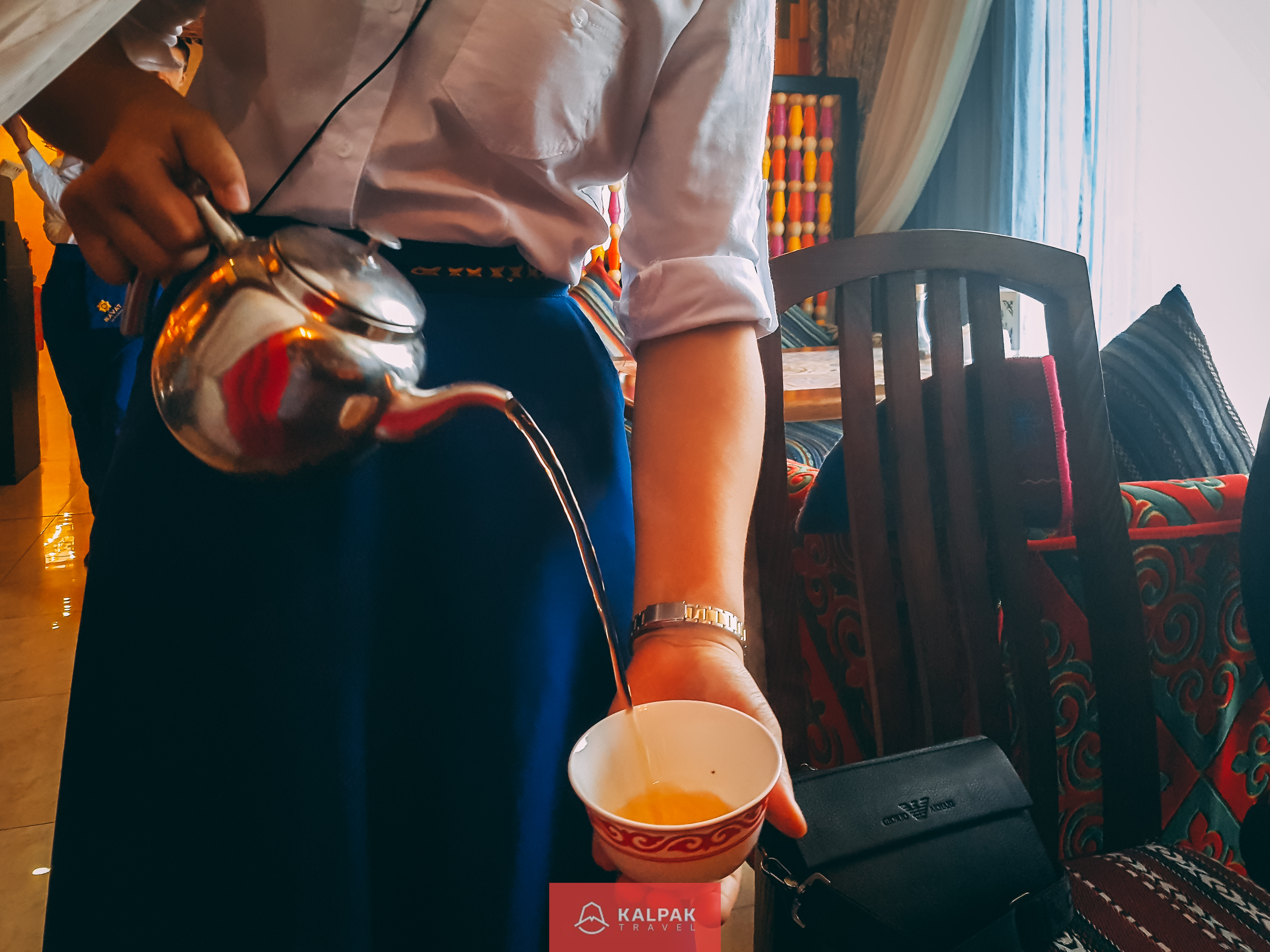
It is served in small half-filled bowls. Serving a full bowl of tea is considered impolite, whereas a full Western-style cup of tea is OK. In some mountainous regions, you’ll also find black tea served with milk, salt and butter.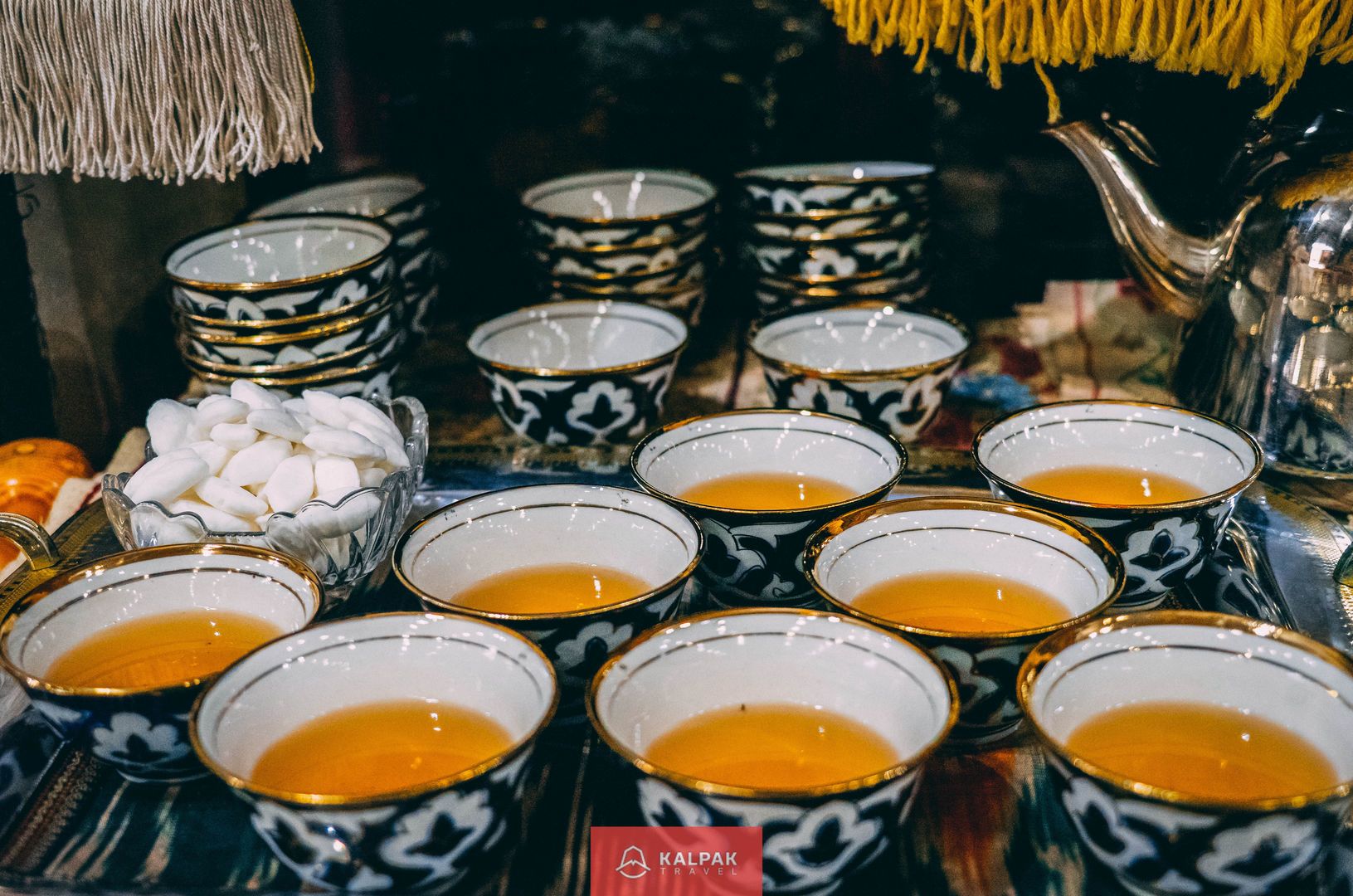
Special drinks and refreshments
Kyrgyz and Kazakh people drink fermented horse milk, called Kymys, Kumys or Кымыз. It has a unique, sour taste. In Kazakhstan, you can also taste camel milk, Shubat (Шубат). It is a once in a lifetime experience to try, but be aware that you might not agree with your stomach if you’re not used to it! On the bustling streets of Bishkek, Kyrgyzstan, you’ll frequently encounter three popular local beverages that capture the essence of the region’s drink culture. These include jarma, a brown drink made from a mixed grain brew, chalap, a white dairy drink, and kvas, a fermented Eastern European beverage traditionally crafted from bread. These refreshing and culturally significant drinks provide a flavorful glimpse into the daily life and culinary traditions of the local residents in Bishkek.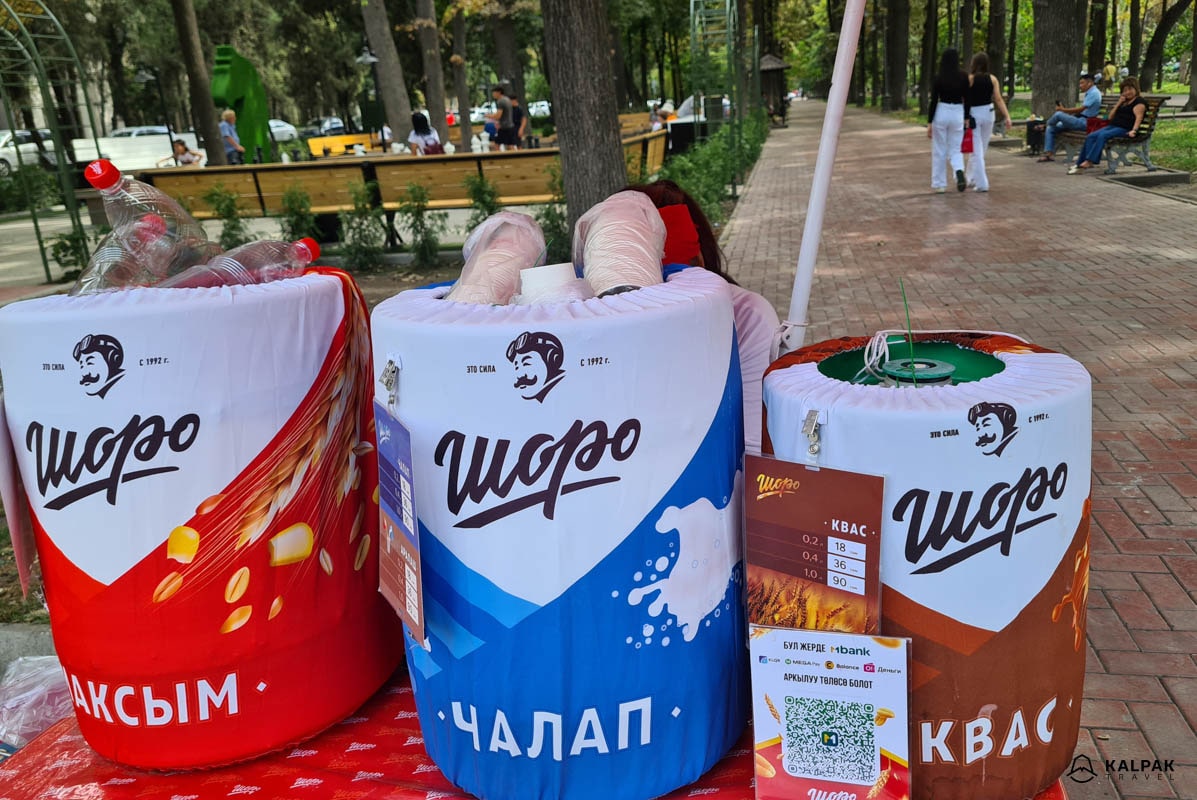
Fruits and vegetables – Овощи и фрукты [Ovoshi i frukty]
The best time to taste Central Asian local produce is summer and the beginning of Autumn. Most common fruits grown locally are apples, pears and apricots. In hotter areas, you can eat grapes, peaches, watermelons, melons, and pomegranates. Peeling fruits and vegetables is recommended
There are also imported fruits like lemons, kiwi, pineapples, bananas etc. 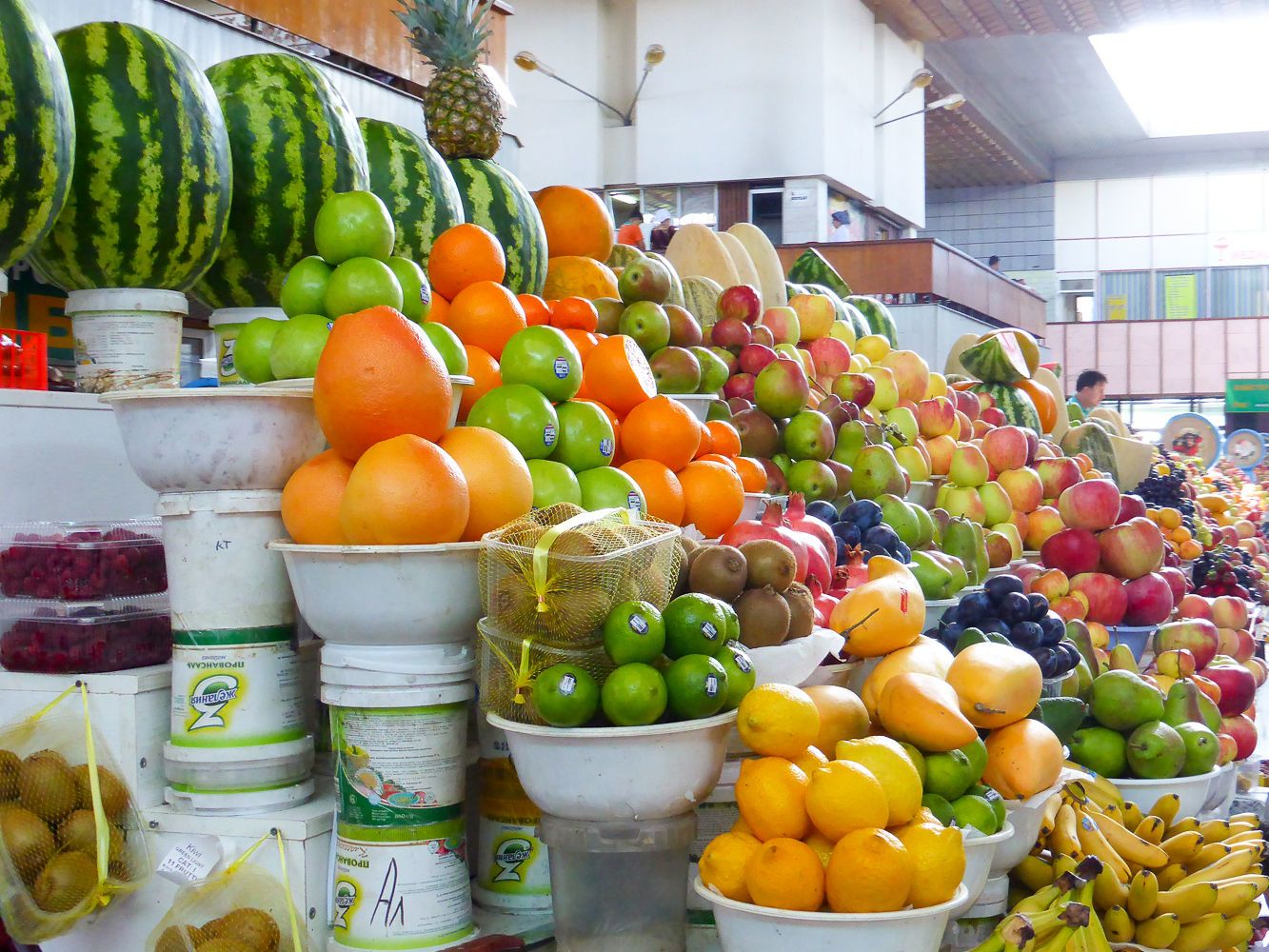
Most common vegetables are tomatoes, cucumbers, cabbage, and bell peppers. 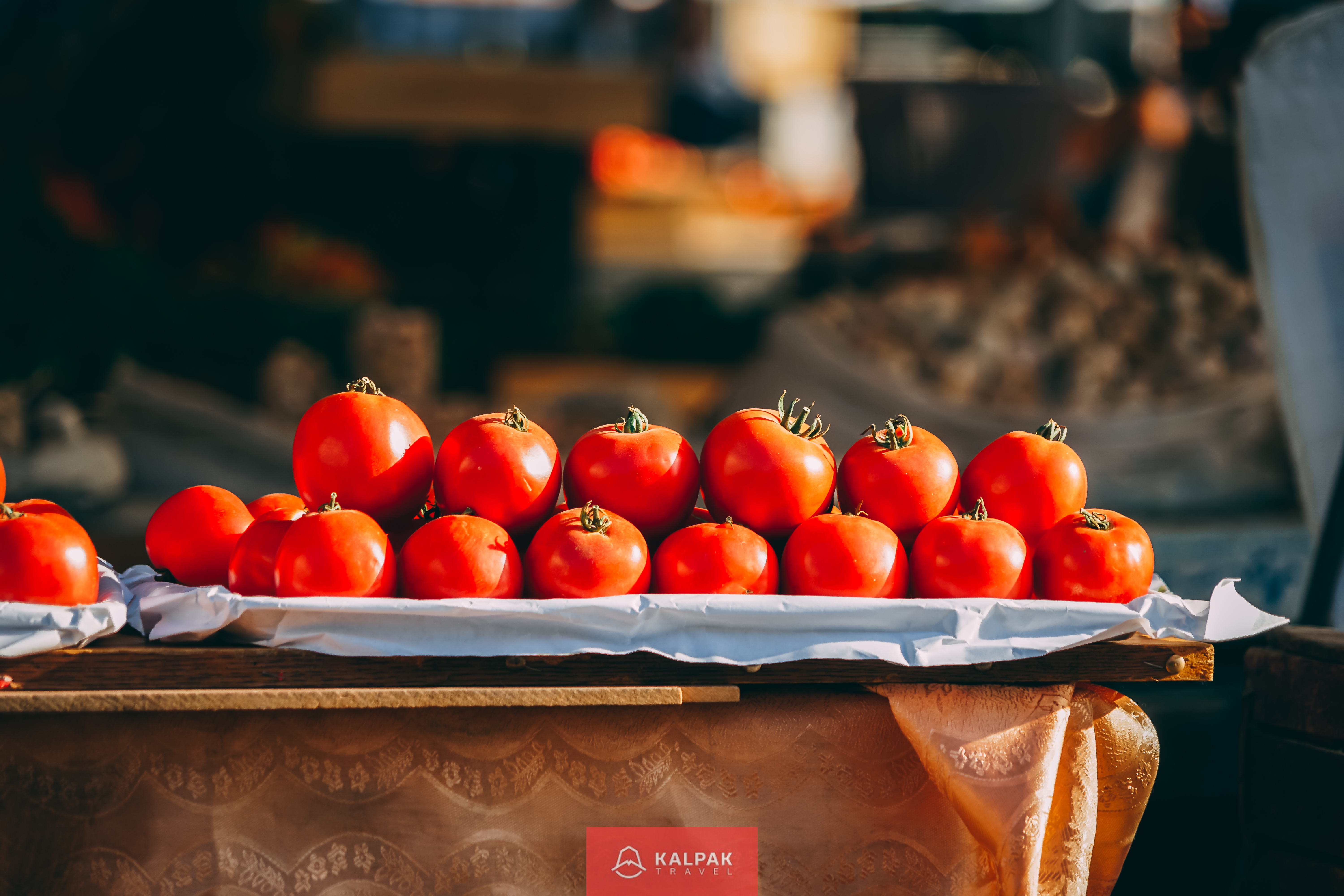
Dried fruits and nuts – Sukhofrukty i Orekhi – Сухофрукты и орехи
Central Asians love dried apricots, raisins and all manner of nuts. Almost every table will have a plate filled with various dried fruits and nuts. In bazaars and supermarkets, you can find a huge variety of such products, perfect for taking with you as a snack for the journey.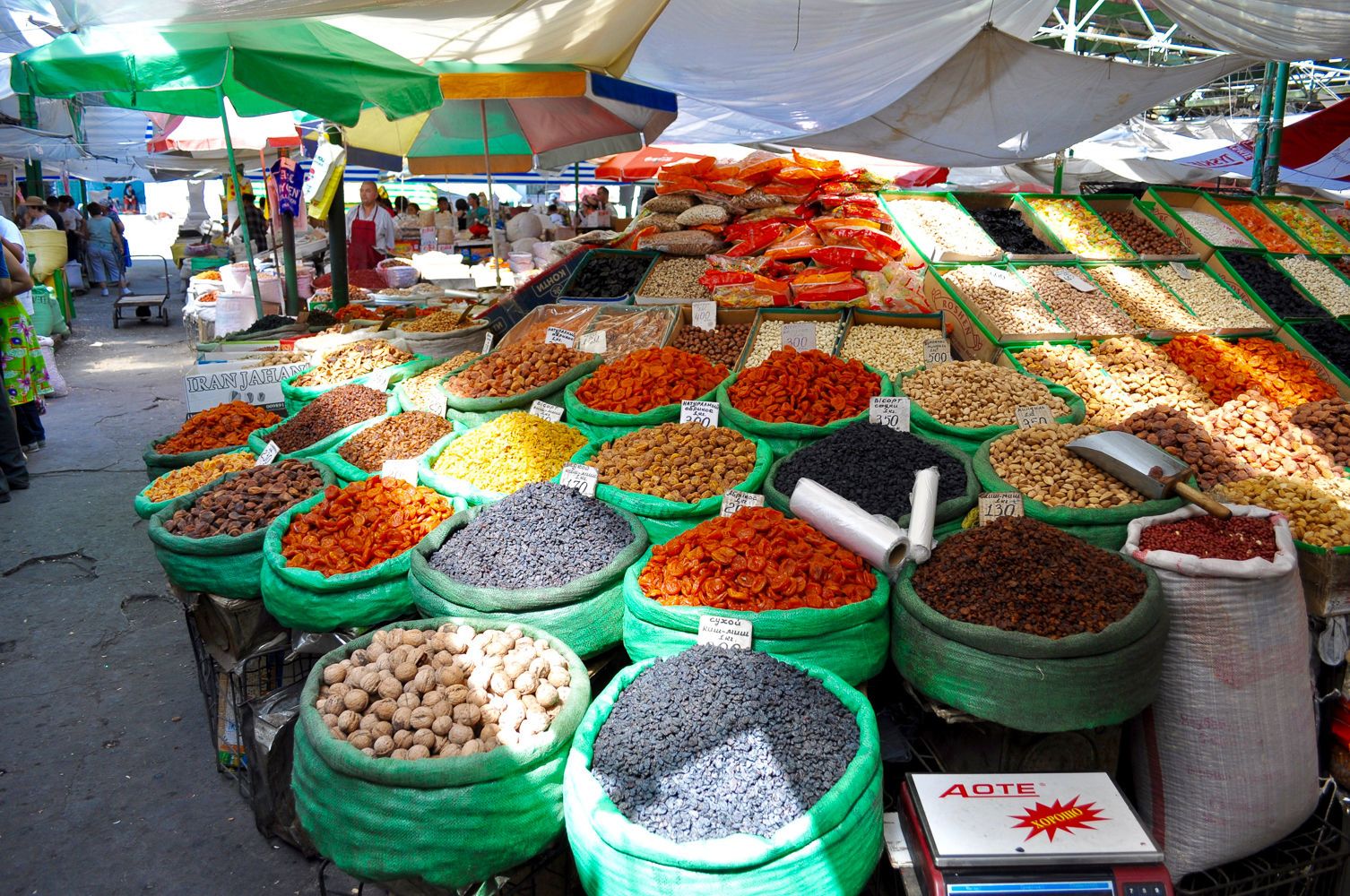
Kurut – Курут
Salty white dairy balls are a popular snack for locals. They’re made of suzmo or drained cottage cheese. If mixed with water you will get the refreshing drink called chalap. If formed into balls and dried, it is called kurut.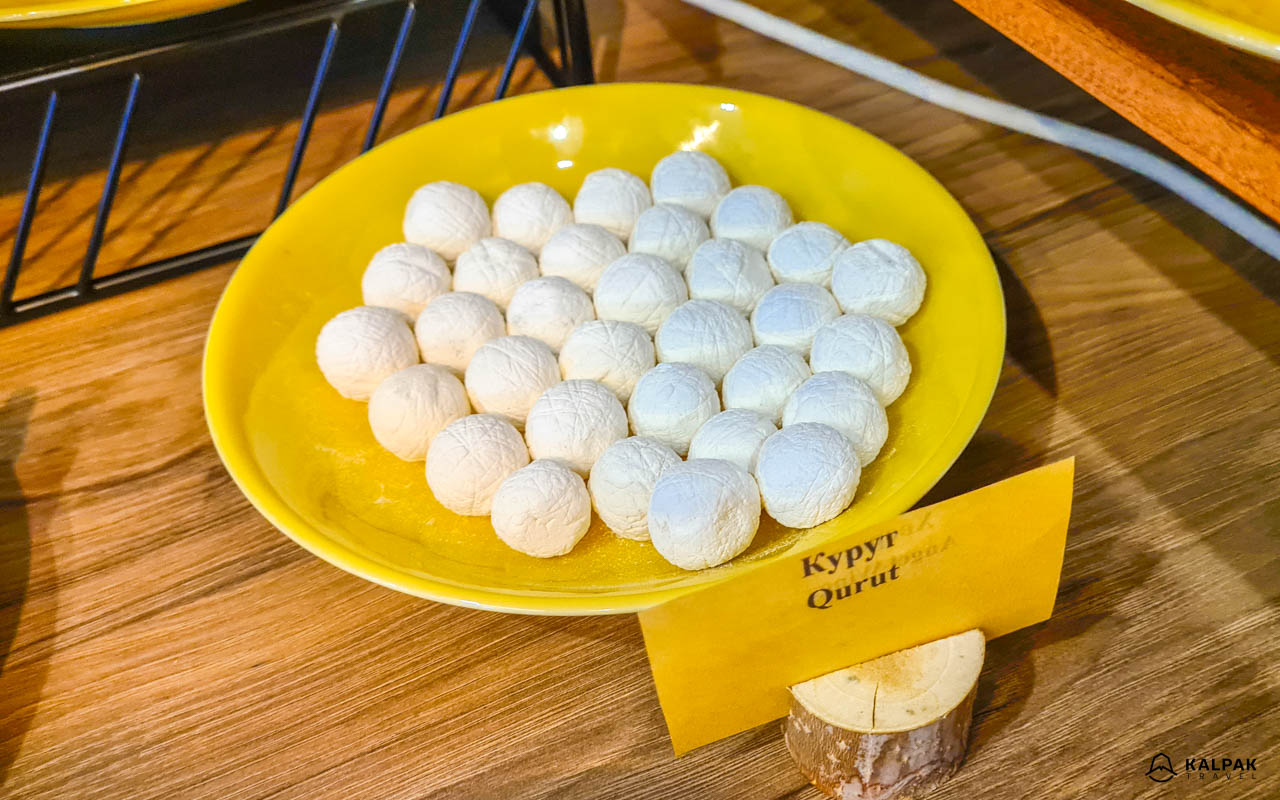
Vegetarians in Central Asia
In large cities, there are a variety of restaurants and plenty of choice in the menu. Vegetarians could try manty with potatoes or pumpkin, lentil soup, plov cooked without meat, vegetarian pizza or side dishes like vegetables, potatoes, rice or pasta.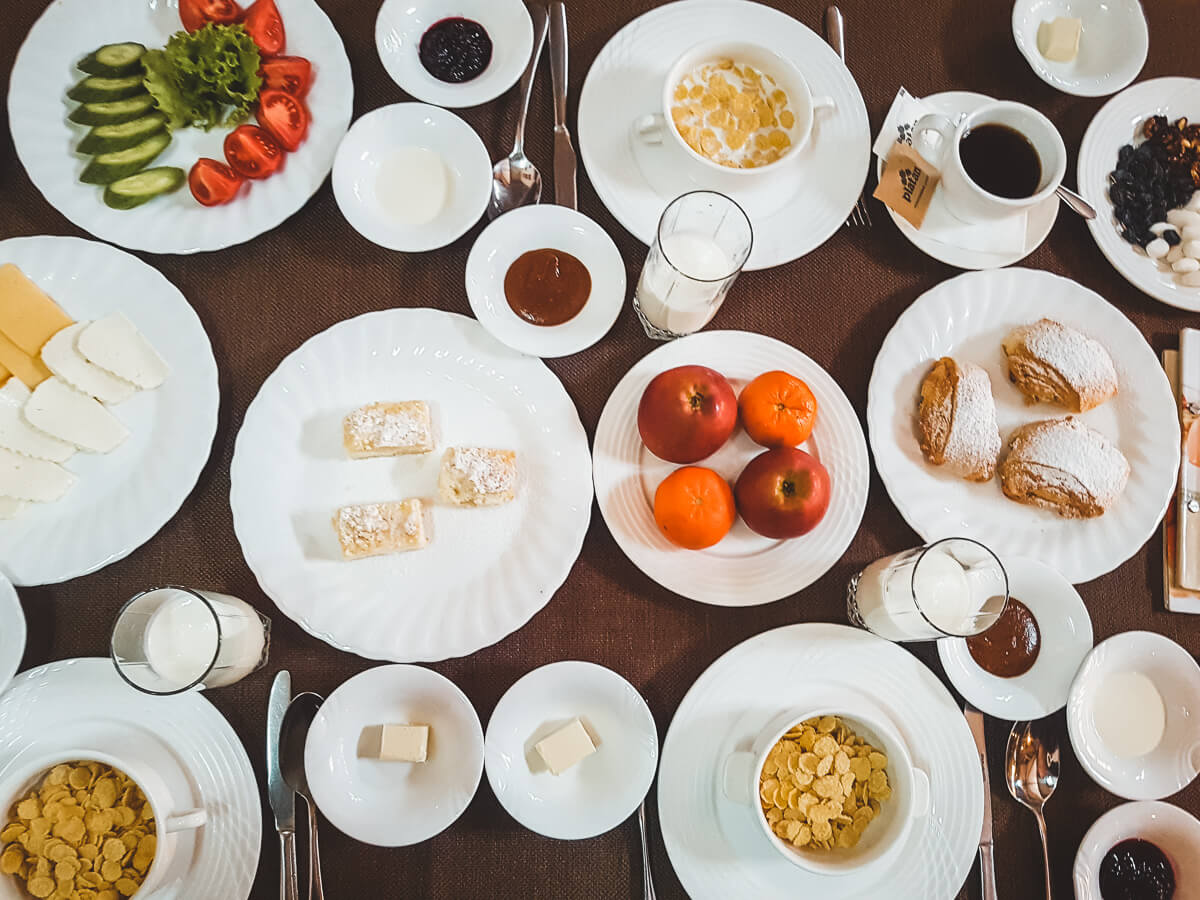
It gets a bit tricky outside those big cities, however, as most dishes are prepared in one pot with meat. You’ll have a hard time in some places convincing the locals that a vegetarian dish can taste good. They’ve been brought up with the notion that the best flavor comes from meat and, as you’re their honored guest, will want to offer you the best food they have – which means meat! As a vegetarian, it’s still possible to travel through Central Asia of course, but make sure your guide and hosts are clear that you don’t wish to eat meat. Kalpak Travel typically arranges vegetarian meals and can assist with this either before your departure or during your tour, with your guide providing support.



